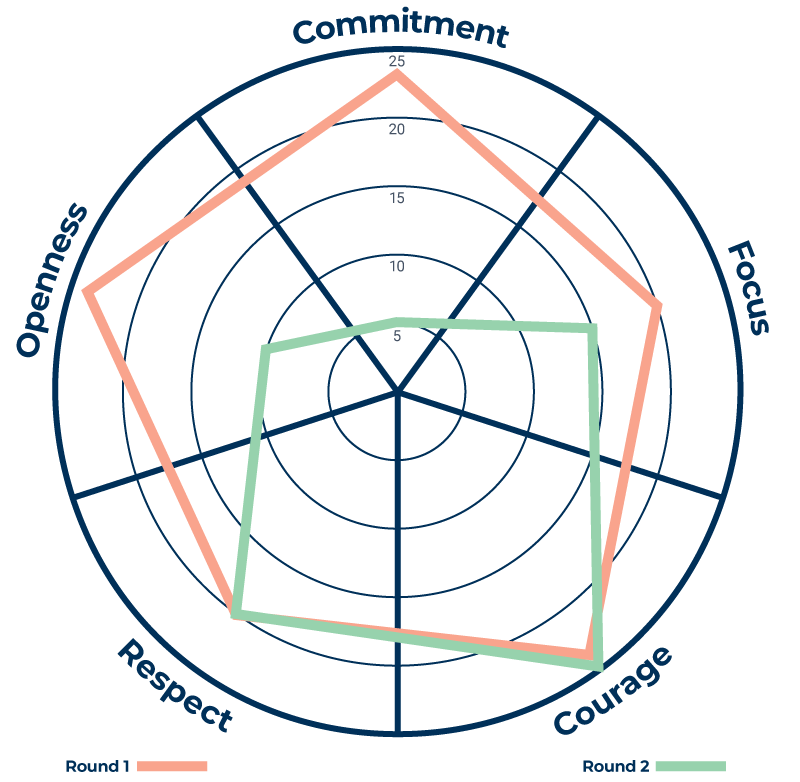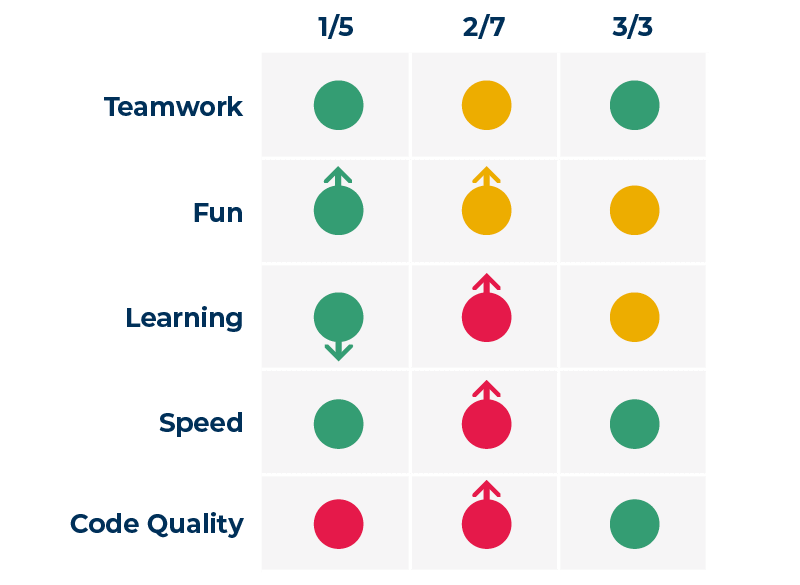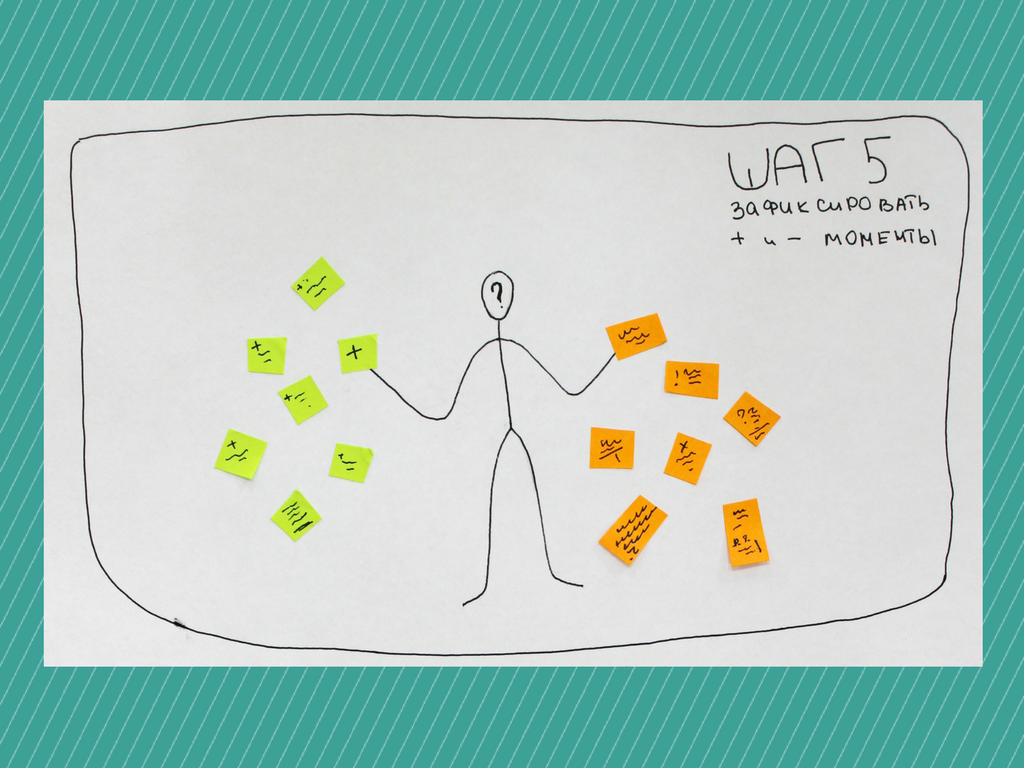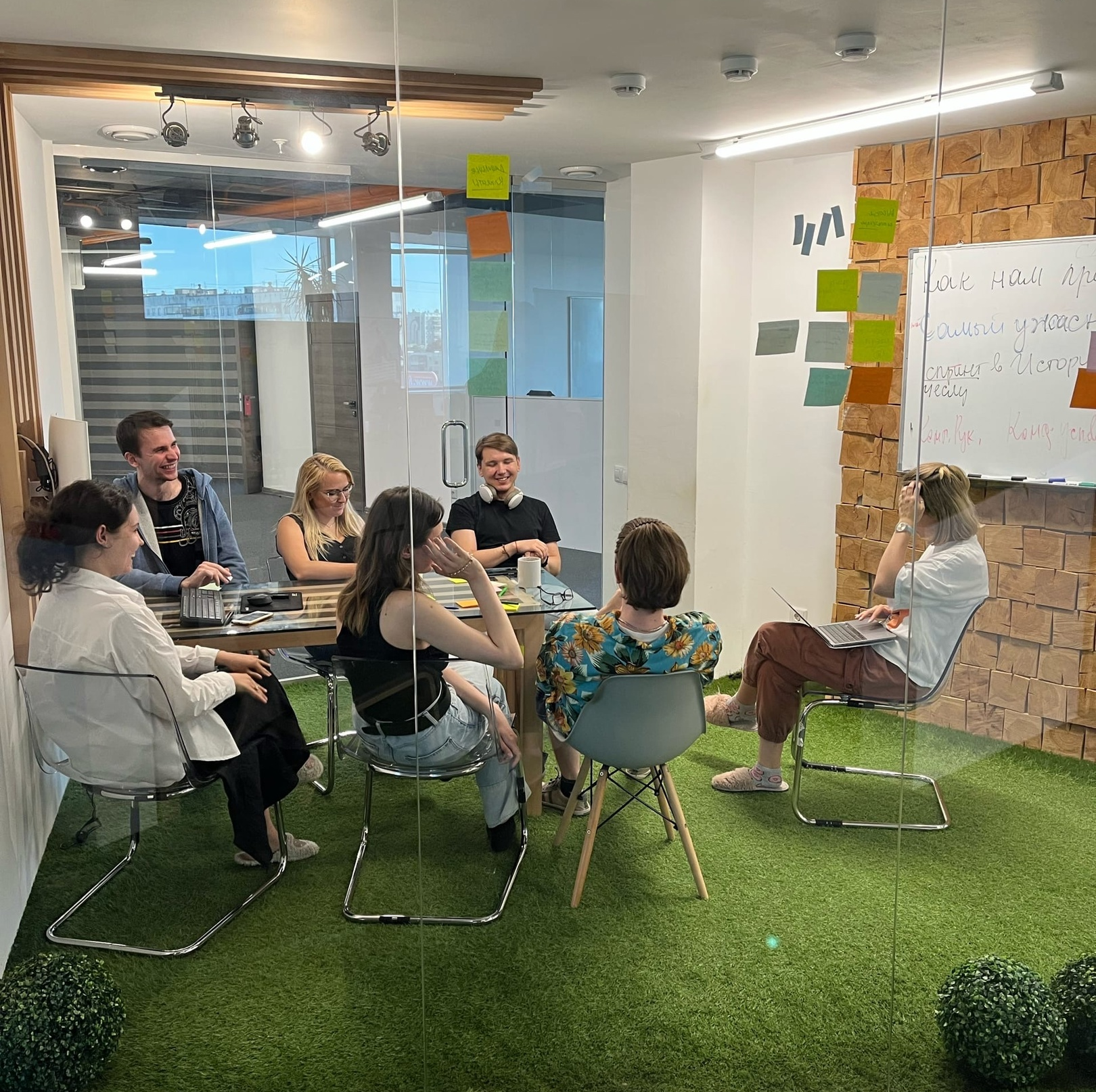Цикл Деминга включает ряд действий, которые выполняются перед принятием управленческих решений. По такой модели проверяется эффективность и экономическая целесообразность новых идей и продуктов. Правильная проверка дает возможность выявить слабые места действующих бизнес-процессов и других важных аспектов, от которых зависит прибыльность компании. При выявлении ошибок и слабых мест они устраняются и заменяются на более эффективные решения, которые также тестируются после внедрения. Чтобы что-то улучшить, согласно циклу Деминга, нужно понять, что не так, исправить это, а потом добиться стабильности процесса.
В Agile методологии для этого создан очень эффективный инструмент — Ретроспектива.
Ретроспектива — это удобный метод для запуска процесса размышления о прошлом, чтобы улучшить будущее.
Это может быть командная или индивидуальная работа цель которой получить план изменений.
Важно понимать, что это план эксперимента на ближайший период. Мы что-то пробуем, а потом смотрим, что из этого вышло, и на основании этого принимаем следующее решение.
Я буду описывать командный процесс, но пусть это не смущает тех у кого нет команды. Все те же тезисы относятся и к проведению индивидуальной ретроспективы.
Часто команды недооценивают «силу» ретроспективы и либо не проводят её совсем, либо проводят очень редко.
Причины, почему команды недооценивают этот метод:
- На ретро зачастую расслабленная атмосфера и создаётся ощущение нерабочего мероприятия
- В команде мало доверия, поэтому открыто обсуждать трудности участники команды не готовы.
- По итогам встречи есть решения, но они не выполняются.
Самый простой и результативный сценарий проведения Ретроспективы:
1 Этап — сонастройка команды
На этом этапе важно включить в работу каждого участника встречи. Задать тон встречи, ответить на вопросы по формату проведения этой встречи.
2. Этап — Обзор спринта, периода, проекта по итогам которых проводится ретроспектива
Этот этап нужен чтобы вернуться к началу спринта или проекта вспомнить какие цели ставила перед собой команда, к каким результатам хотели прийти.
3 Этап — Плюсы и благодарности
Самое время отметить всё положительно что произошло за этот период, выразить благодарность, отметить что помогало справиться с вызовами, зафиксировать все победы и успехи, присвоить результаты команде.
4 Этап — Минусы
Это самый важный момент ретроспективы — здесь надо максимально честно выгрузить всё что мешало достижению целей, как команде в целом, так и каждому участнику в отдельности.
5 Этап — План улучшений
На этом этапе появляются идеи как улучшить, исправить, сделать по другому, сделать лучше. На каждый минус который в предыдущем этапе записали участники ретроспективы пишем минимум одну идею по улучшению.
6 Этап — Итоги
На этом этапе идет интеграция целей, плюсов и идей. Команда договаривается какие цели они берут в будущий период, какие ресурсы они будут использовать и какие идеи по улучшению нужно будет реализовать чтобы достичь выбранных целей.
7 Этап — Завершение встречи
Это важный этап где каждый участник ретро делится с какими идеями и мыслями уходит с этой встречи.
Этот сценарий проведения ретроспективы не является единственно рабочим или обязательным, можно добавлять дополнительные активности, можно делить на две встречи.
Также, этот же сценарий проведения встречи может быть использован для индивидуальной ретроспективы. Например, эксперты и самозанятые работают без регулярной команды — это не значит что для них не применим этот инструмент. Наоборот — это также эффективно работает в индивидуальном формате.
Ретроспектива
Проанализируйте успехи, неудачи и их причины, чтобы понять, как сделать командную работу еще лучше. Ретроспективу рекомендуется проводить вместе с командой каждые две недели или в конце контрольной точки проекта.
Время на подготовку
15 минут
Время проведения
60 минут
Участники
4–8 человек
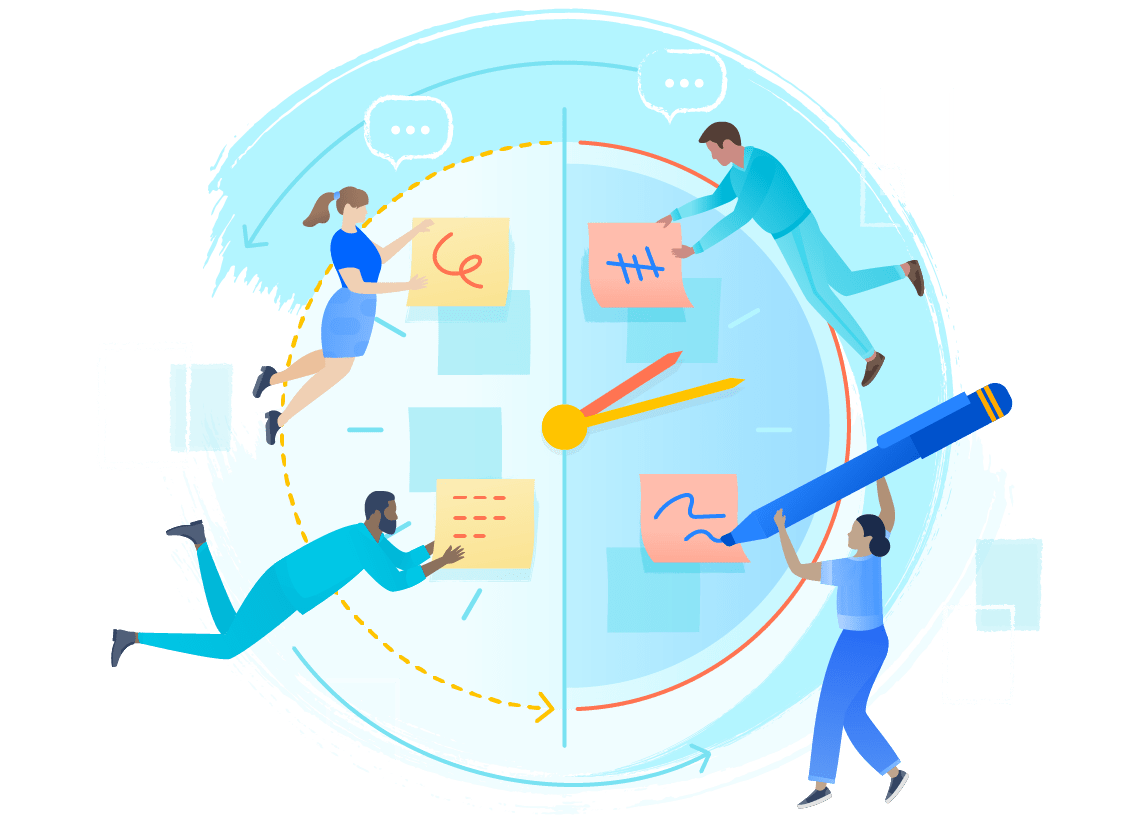
Ретроспектива
Проанализируйте успехи, неудачи и их причины, чтобы понять, как сделать командную работу еще лучше. Ретроспективу рекомендуется проводить вместе с командой каждые две недели или в конце контрольной точки проекта.

Время на подготовку
15 минут
Время проведения
60 минут
Участники
4–8 человек
Ретроспектива
Проанализируйте успехи, неудачи и их причины, чтобы понять, как сделать командную работу еще лучше. Ретроспективу рекомендуется проводить вместе с командой каждые две недели или в конце контрольной точки проекта.
Время на подготовку
15 минут
Время проведения
60 минут
Участники
4–8

Ретроспективы на практике
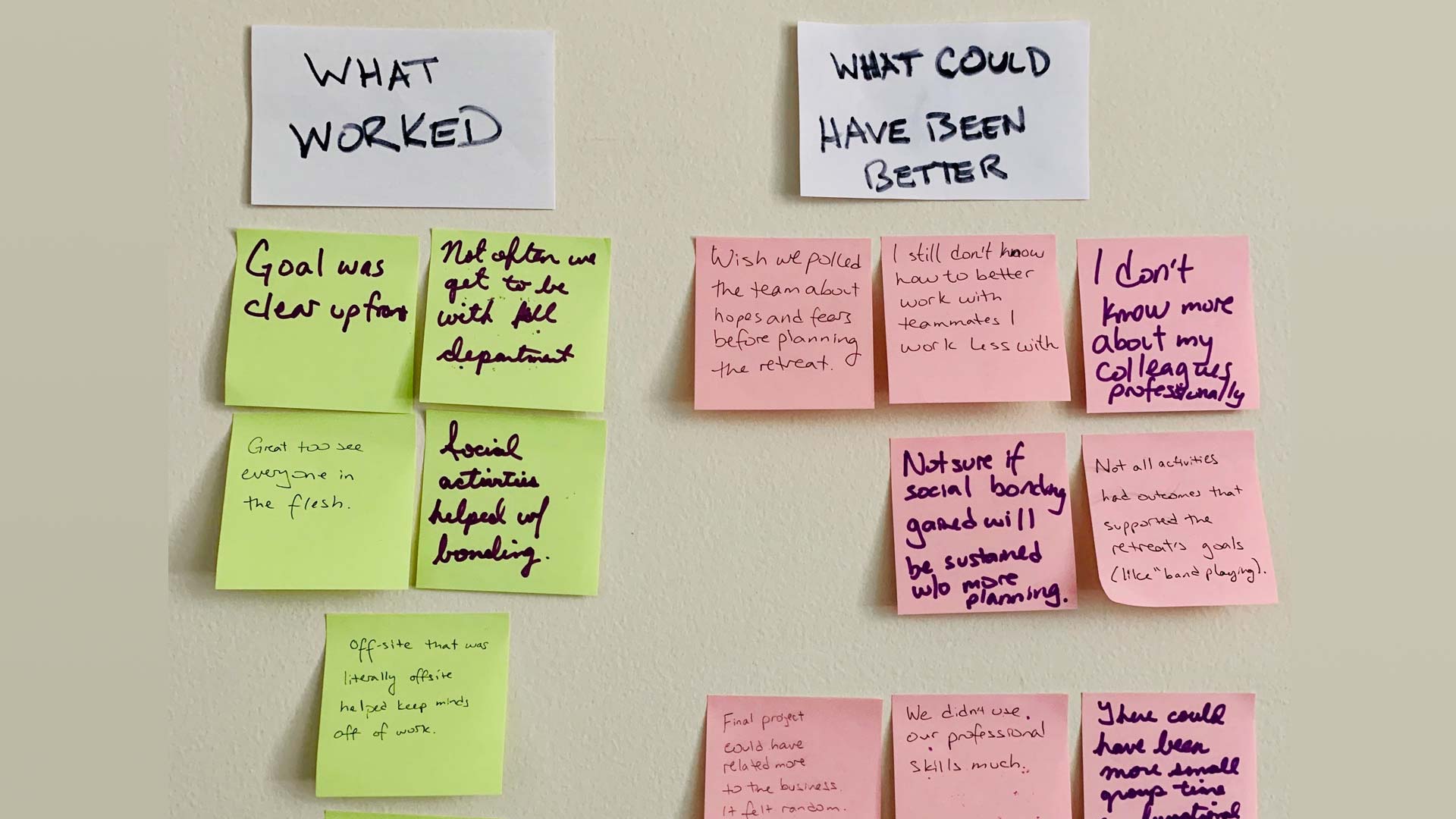
Стикеры команды с выездной ретроспективы.
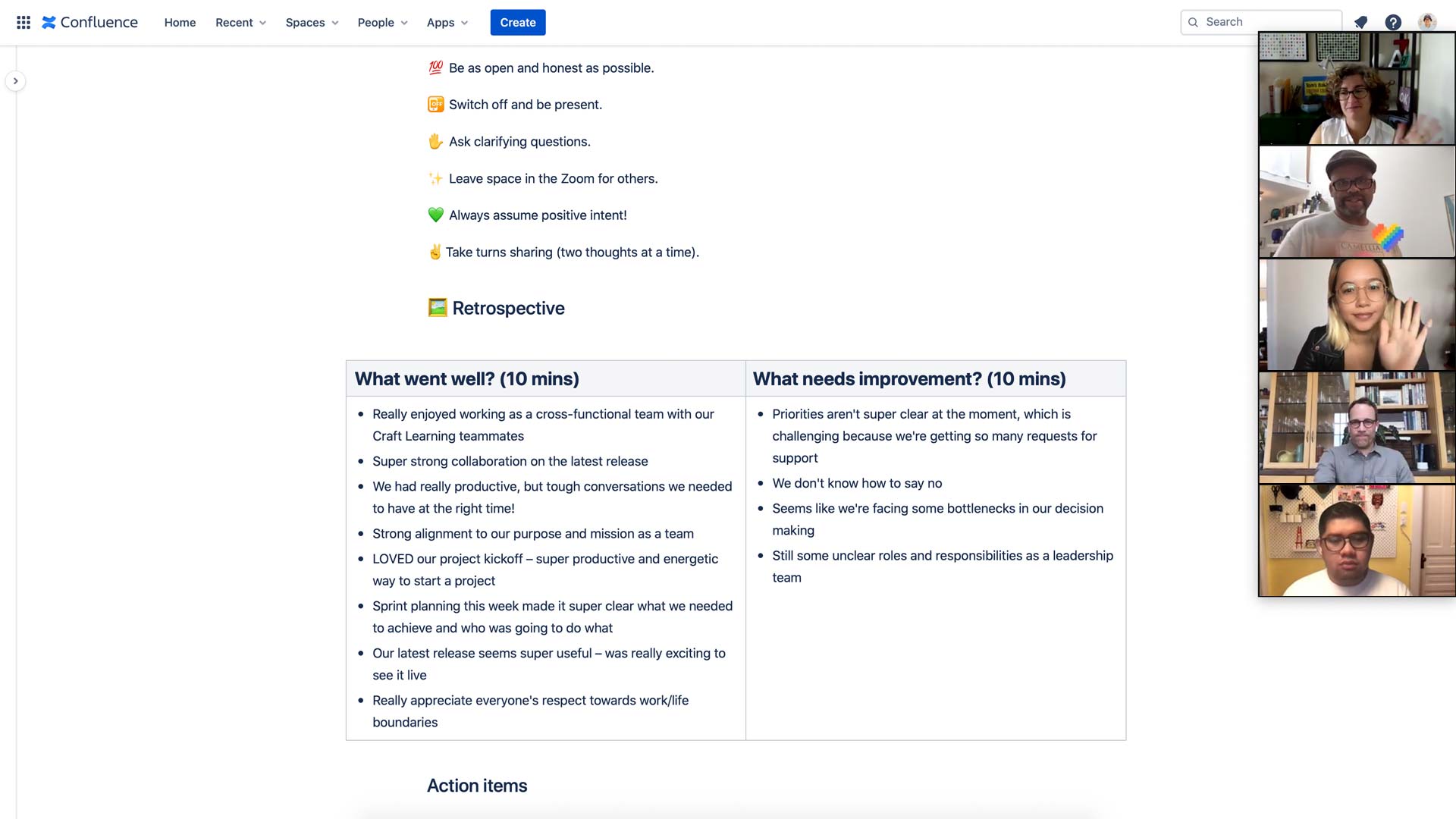
Эта команда использовала Confluence, чтобы подвести итоги обсуждения в ходе ретроспективы.
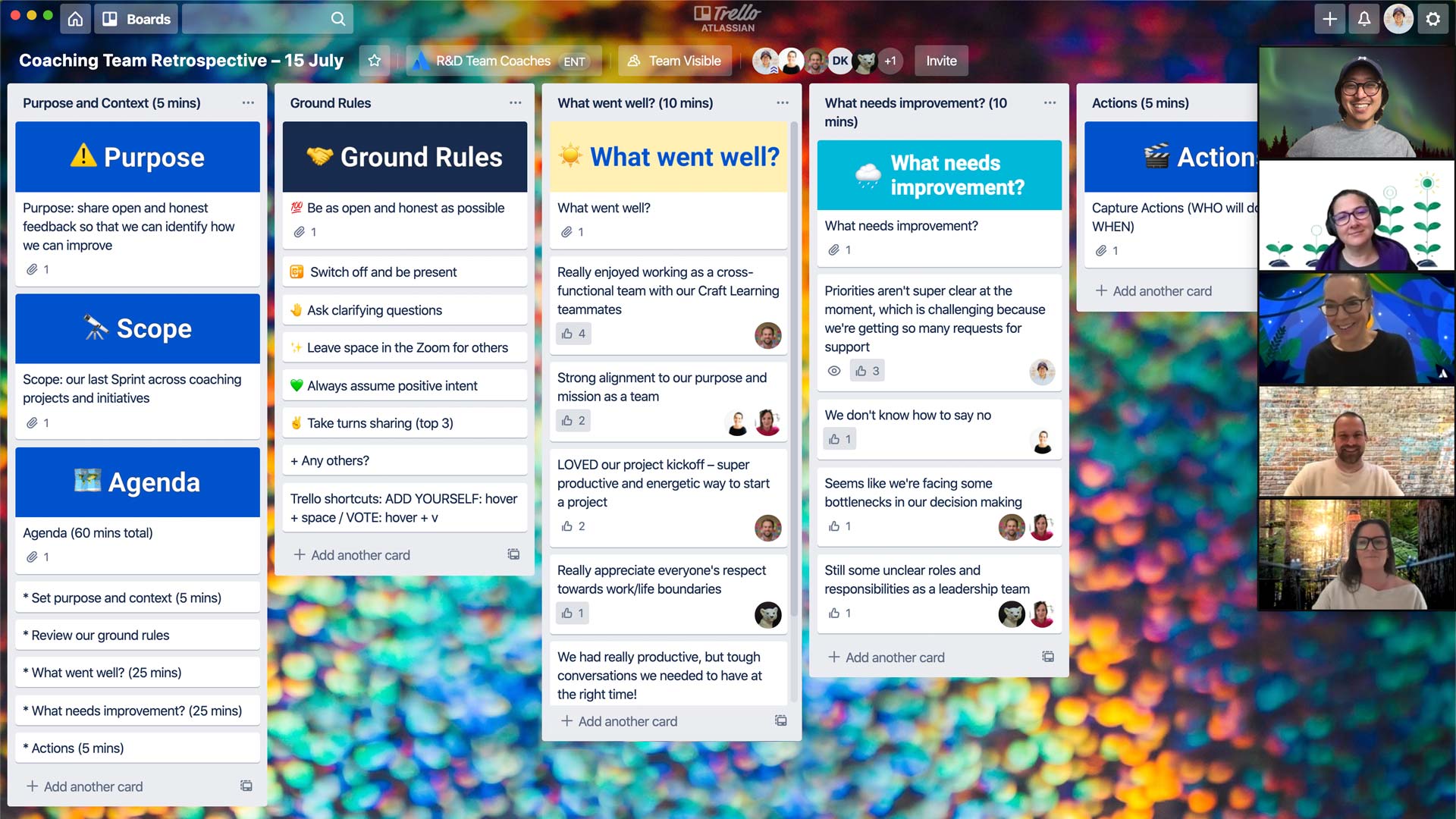
Ретроспектива, транслируемая через Zoom, в ходе которой в Trello участники формулировали базовые правила, добавляли идеи и направляли обсуждение в нужное русло.
Что вам понадобится
Удаленно
Видеоконференция с возможностью демонстрировать экран
Цифровой инструмент для совместной работы (см. шаблоны)
Очно
Пространство для собрания
Доска или большой лист бумаги
Маркеры
Стикеры
Таймер
Дополнительные шаблоны
Инструкции по проведению этого сценария
1. Подготовьтесь 15 минут
Если команда проводит сценарий удаленно, для начала создайте новый документ для совместной работы, например страницу Confluence или доску Trello. Для справки можно обратиться к шаблонам (см. выше).
Если команда проводит сценарий в очном порядке, приготовьте доску или большой лист бумаги и разложите листки для заметок (стикеры) и маркеры в комнате для собраний.
На странице Confluence, доске Trello, бумаге или обычной доске сделайте три столбца с заголовками «Что нам удалось», «Что мы можем делать лучше» и «Действия».
По возможности попросите нейтрального стороннего человека помочь с проведением собрания. Благодаря этому участники собрания будут сильнее вовлечены в процесс и вы сможете вскрыть больше неочевидных закономерностей.
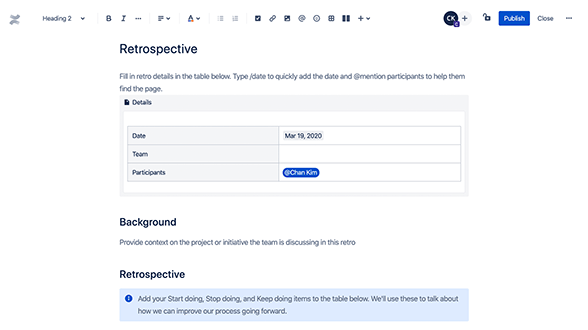
Пример: Confluence
Проводите этот сценарий удаленно? Используйте бесплатный шаблон ретроспективы, чтобы направлять беседу в нужное русло и фиксировать данные, полученные в результате этого семинара.
2. Заложите фундамент 5 мин
- Не переходите на личности и не принимайте на свой счет мысли других участников.
- Воспринимайте информацию непредвзято.
- Опыт каждого сотрудника имеет значение.
- Определите, какой временной период вы будете обсуждать (последний спринт, последний квартал, весь проект и т. д.).
- Не ищите виноватых. Лучше сосредоточьтесь на том, как добиться улучшения.
Если вы уже проводили ретроспективу ранее, быстро просмотрите темы и действия из прошлого семинара, чтобы обеспечить целостность.
Совет. Адаптируйте этот список к своим потребностям
Меняйте правила с учетом уникальных потребностей команды. Добавьте все, что, по вашему мнению, поможет вашей команде стать лучше.
Совет. Создайте безопасное пространство
Решите, как нужно обсудить информацию после сценария. Будет ли она передана руководству? Возможно, вам следует придерживаться правила Чатем-Хауса.
3. Что нам удалось 15 минут
Попросите каждого участника записать на стикерах успехи команды (по одному пункту на стикер). Затем разместите стикеры на цифровой или реальной доске. Объедините похожие или повторяющиеся идеи. Кратко обсудите каждую идею всей командой.
4. Что мы можем делать лучше 10 мин
Пусть все напишут, что, по их мнению, можно улучшить (по одному пункту на стикер). Расклейте стикеры на доске и объедините похожие или повторяющиеся идеи. Обсудите каждую тему всей командой.
Совет. Убедитесь, что никого не проигнорировали
Если обсуждением полностью завладели один или два человека, ведущий должен вмешаться и дать слово другим участникам, прежде чем переходить к следующему этапу.
5. Действия 10 мин
Предложите всем подумать о том, какие действия можно предпринять, чтобы добиться улучшения в проблемных зонах (по одному пункту на стикер).
Расклейте стикеры на доске и объедините похожие или повторяющиеся идеи. Обсудите каждую идею всей командой и в случае необходимости назначьте ответственных за эти действия, а также сроки для их выполнения.
Совет. Обновите рабочие процессы
Если каким-либо действиям соответствуют задачи в Jira, добавьте на страницу ссылки на них, чтобы упростить проверку статуса задачи.
Уделяйте время действиям, определенным на ретроспективе, например на стендапах или при еженедельном обмене новостями о статусе команды.
Последующие действия
Подвергайте основные выводы критической оценке
Выполняются ли последующие задачи, или о них забывают? Понимаете ли вы основную причину проблем? Поможет ли другой набор мероприятий копнуть глубже? Ретроспективы можно менять — адаптируйте их под свои нужды!
Варианты
План последних двух месяцев
Нарисуйте временную шкалу, охватывающую последние два месяца, и затем попросите участников команды назвать важные события. Это поможет освежить в памяти все, что произошло за эти месяцы, и заложить фундамент в начале сценария.
ТОЧЕЧНОЕ ГОЛОСОВАНИЕ
Если в категории «Действия» набирается много идей, проголосуйте, чтобы выбрать наиболее приоритетные.
Если вы используете Trello, предложите команде проголосовать за три идеи, которые участники хотели бы видеть вверху списка. Для этого можно добавить себя к карточке (горячая клавиша: «Пробел» при наведении курсора на карточку). Выберите, кто будет ответственным за выполнение действий, получивших наибольшее число голосов.
Если собрание проводится в очном порядке, пусть каждый возьмет маркер и поставит точку рядом с тремя понравившимися идеями. Подсчитайте количество точек и сделайте то же, что описано выше.
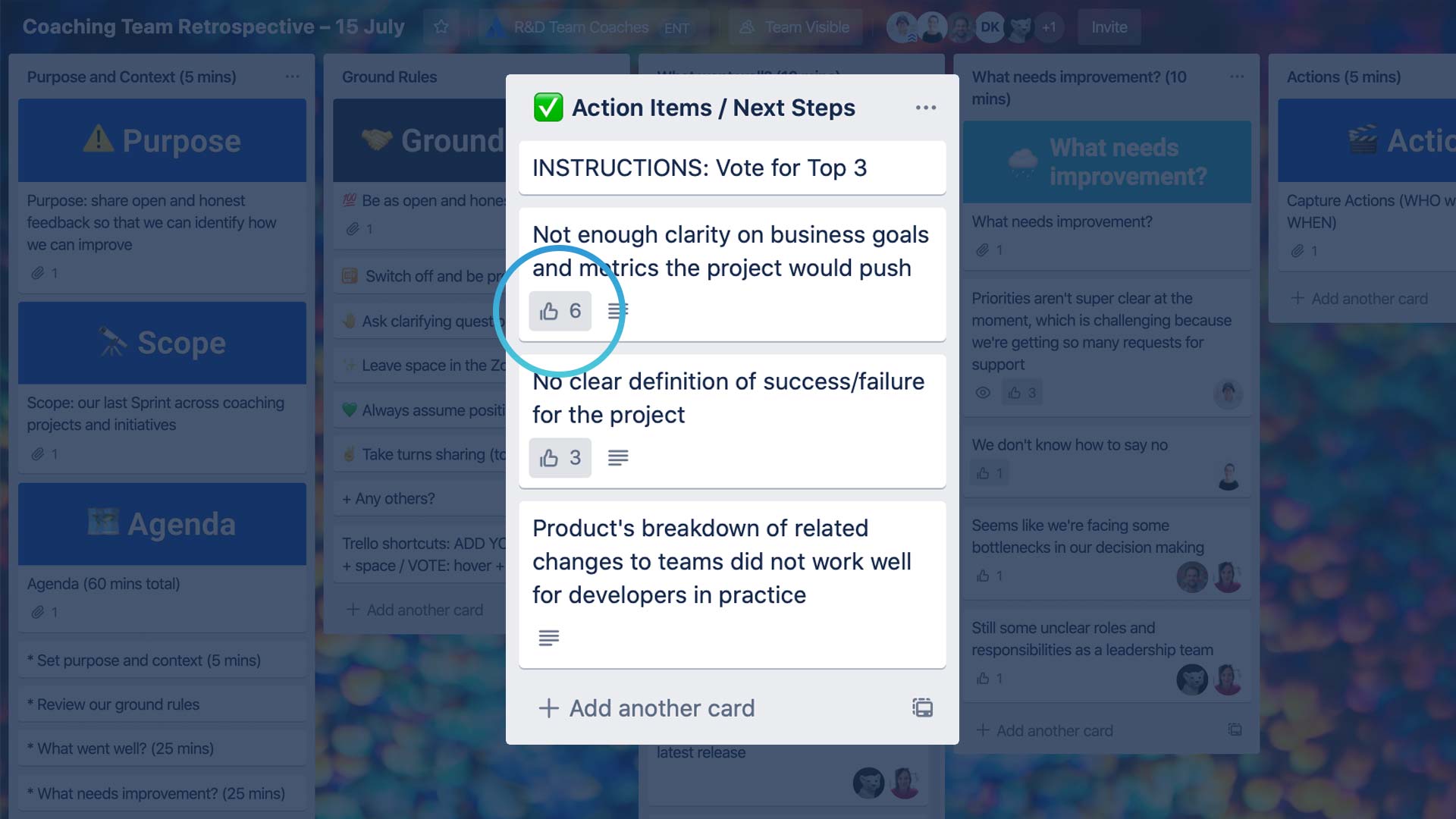
ТОЧЕЧНОЕ ГОЛОСОВАНИЕ
Если вам нужно прийти к единому мнению о новых идеях, используйте «точечное» голосование, чтобы вести обсуждение.

Остались вопросы?
Поговорите с другими пользователями сборника Atlassian Team Playbook, получите поддержку или оставьте отзыв.
Сообщество Atlassian

Остались вопросы?
Поговорите с другими пользователями сборника Atlassian Team Playbook, получите поддержку или оставьте отзыв.
Сообщество Atlassian
Изучите другие сценарии
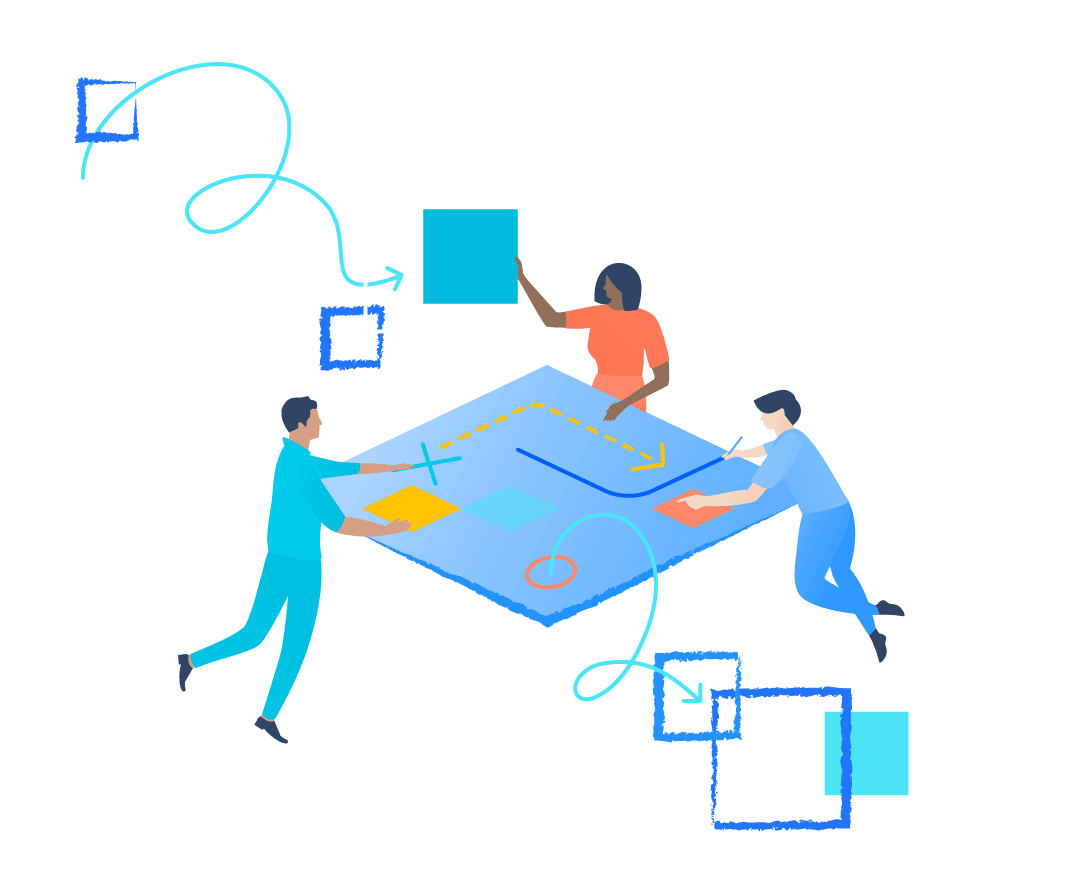
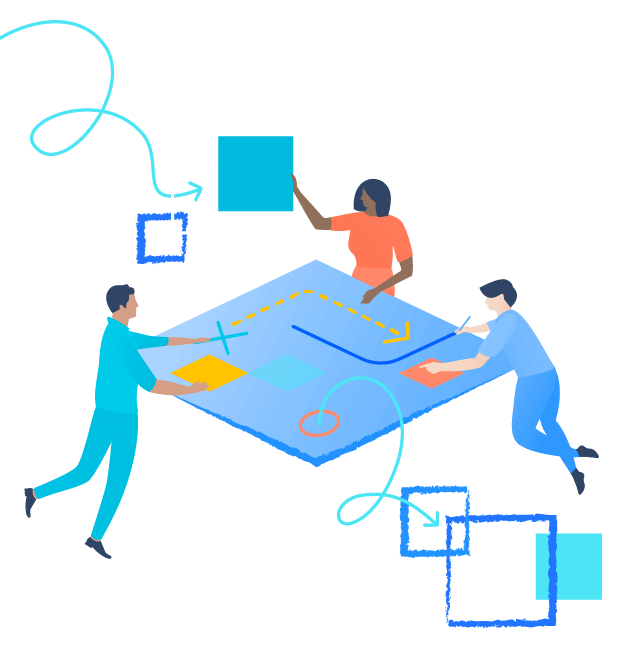
От наших команд — вашим
Подпишитесь на нашу ежемесячную информационную рассылку и будьте в курсе новейших сценариев, советов и рекомендаций.




Ребята, материалов в интернете о том, как проводить ретроспективу масса, а каждый раз приходится составлять скрипт с нуля. Буквально каждый день запускается команды, назначаются скрам-мастера, а им в свою очередь нужен простой готовый формат «делай как я», чтобы потом можно было применить на практике.
По мере подготовки сценариев, они будут публиковаться в нашем блоге и ссылки в группе в Facebook.
Сценарий ретроспективы: Первая ретроспектива.
Этот сценарий рекомендуется тогда, когда у команды давно не было ретроспективы (месяц и более) и вам нужно вдохнуть в них свежий воздух перемен.
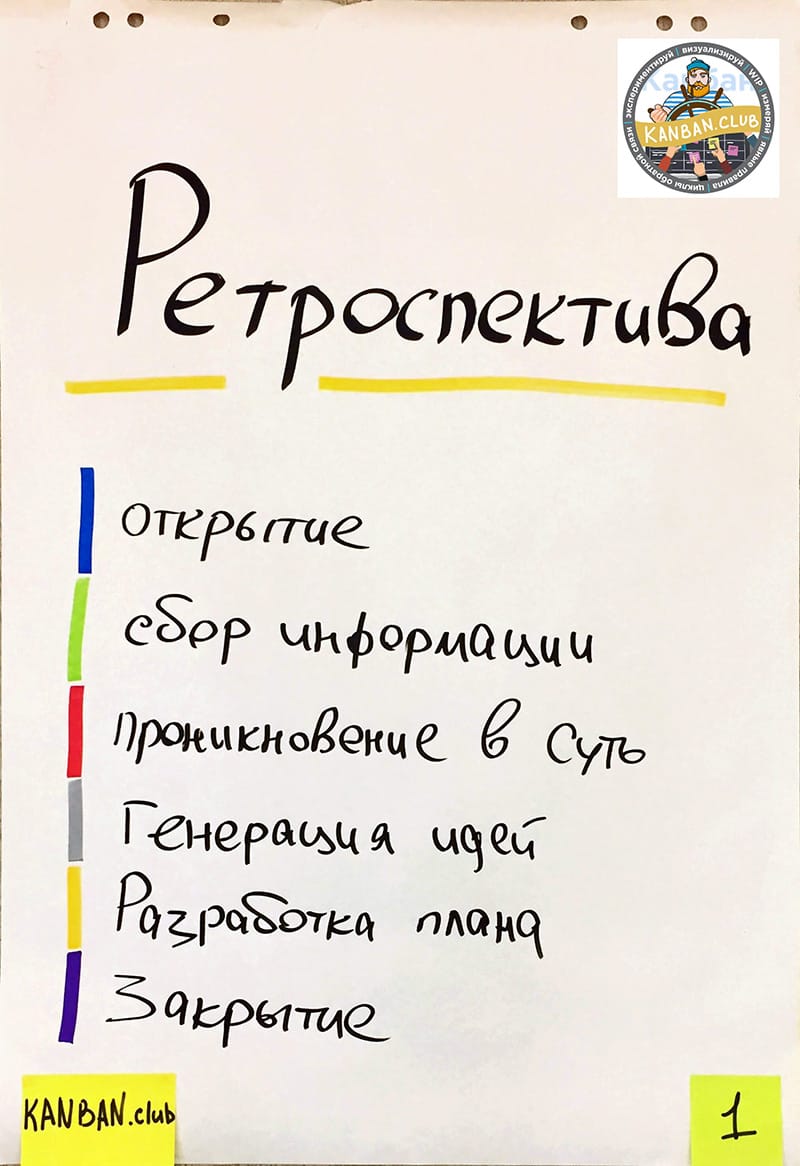
Ретроспектива — это встреча, которая позволяет команде выявить собственные зоны роста, разработать изменения, организовать решение текущих проблем и предотвратить текущие трудности.
Цель ретроспективы: совершенствование рабочих процессов.
Время проведения: около 2-х часов
Участники: вся команда
Цели этапов ретроспективы:
- Открытие.: «разогреть» и познакомить участников
- Сбор информации.: создание общего контекста для текущей ситуации
- Проникновение в суть: проанализировать причины текущей ситуации
- Генерация идей: поиск идей для решения текущей ситуации
- Разработка плана: выбор идеи и составление плана ее реализации
- Закрытие: подведение итогов церемонии и завершение групповой коммуникации на позитивной ноте.
Прежде чем начать, вам нужно убедиться, что у вас есть достаточное место для того, чтобы вся команда могла сидеть по кругу и между вами не было никаких столов. Т. е. чистая комната, стулья, флипчарт и на стены есть возможность клеить листы флипчарта на малярный-скотч. Обеспечьте возможность участникам видеть и разговаривать друг другом без каких-либо препятствий. Эта обстановка побуждает, естественным образом, отказываться от ноутбуков и мобильных телефонов. Запаситесь большим количеством стикеров, маркеров и малярным скотчем.
Имаджинариум (открытие)
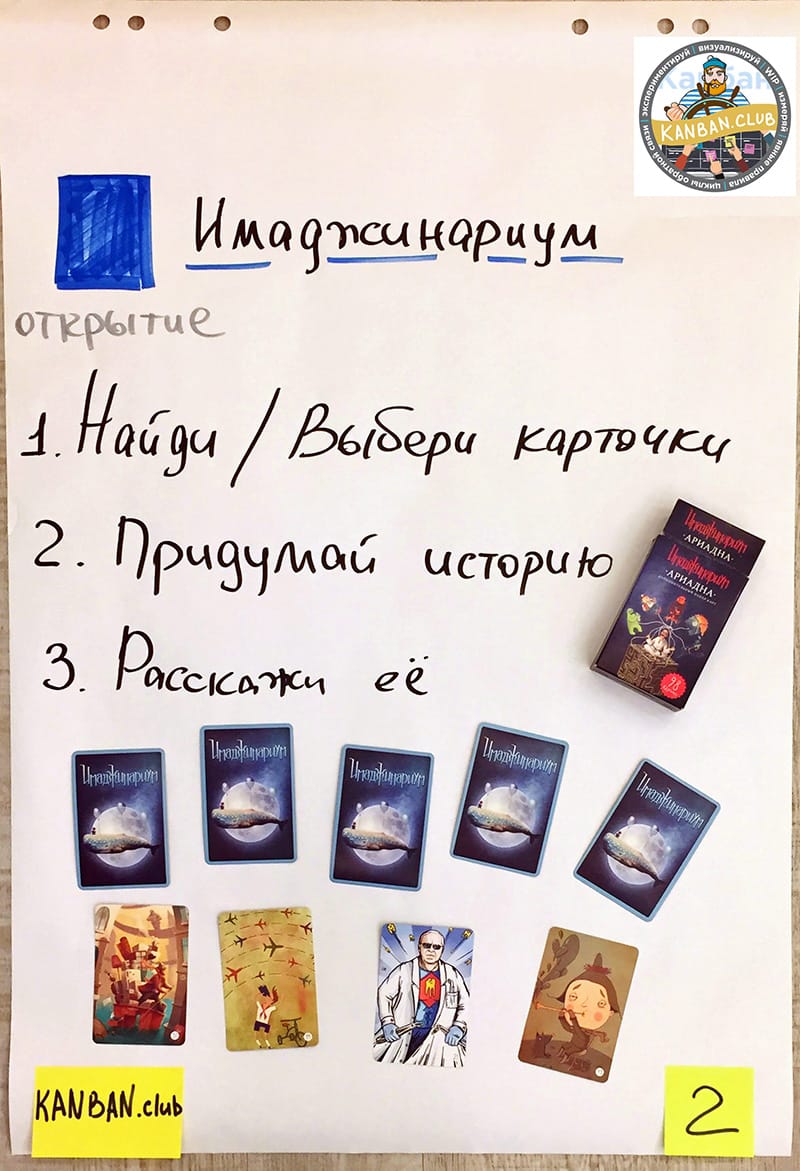
Для проведения этого упражнения, вам понадобятся карточки с креативными картинками.
- Каждый участник получает по 3 карты.
- Фасилитатор спрашивает у группы за какой период будем проводить ретроспективу? (Это может быть спринт, календарный месяц, квартал или какая-то произвольная дата, но которая что-то значит для команды)
- Дальше за 3 минуты участники придумывают, как с помощью имеющихся картинок рассказать о том, что было за прошедший период. Важно, чтобы участники делали это молча и самостоятельно. Это индивидуальное упражнение.
- Каждый, по очереди, в произвольном порядке, выходит перед командой и рассказывает свою историю и показывая картинки.
- Хлопаем каждому участнику, в конце выступления, — это позволяет создать доверительную атмосферу и снимает страх выступления для интровертов.
График эмоций (сбор информации)
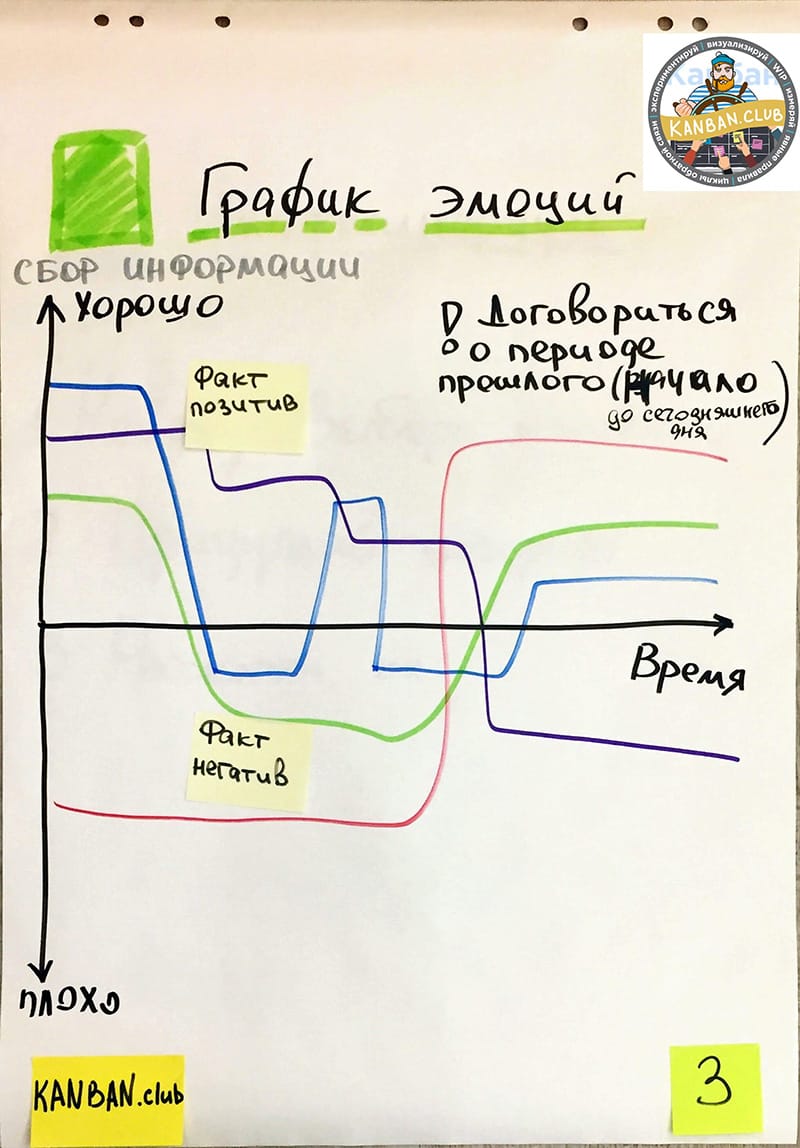
Рисуем график с горизонтальной линией по середине. Размечаем на нем период за который мы делаем ретроспективу с указанием промежуточных точек. Это могут быть понедельники, дни или месяца в зависимости от продолжительности рассматриваемого периода. Цель, чтобы у команды было 3-5 опорных точек, к которым они смогут привязывать свои события и понимать масштаб одинаково.
Рисуем вертикальную шкалу — это эмоции. Точка — 0, это нейтральное положение, чем выше от нее, тем сильнее положительная эмоция, и чем ниже, тем сильнее негативная. Эмоции нужно называть, чтобы другие участники могли понять, что чувствовал в этот момент выступающий и, возможно, проявить к нему эмпатию.
Формат следующий:
- 2 минуты на подумать — молча и самостоятельно
- По одному выходить к графику и рисовать линию, как изменялась его эмоциональное состояние на протяжении указанного времени
- В точках, где настроение стало расти, падать или идти ровно, нужно спрашивать, а что там было. Записывать факт (упал стенд, был в отпуске, остался без поддержки, выпустили релиз и т. д.) этого события и клеить стикер в место, когда он случился.
- Группа при этом может задавать уточняющие вопросы. Дискуссия идет только между выступающим и одним из участников. Беседы между участниками, нужно пресекать. У них будет время это все обсудить.
- По результатам у нас получается общая карта настроений команды и факты, которые имели место быть у команды. Этим мы собрали информацию из каждого, получили объективную картину команды на произошедшие события, помогли им вспомнить или узнать, что было.
Пять Почему. (проникновение в суть)
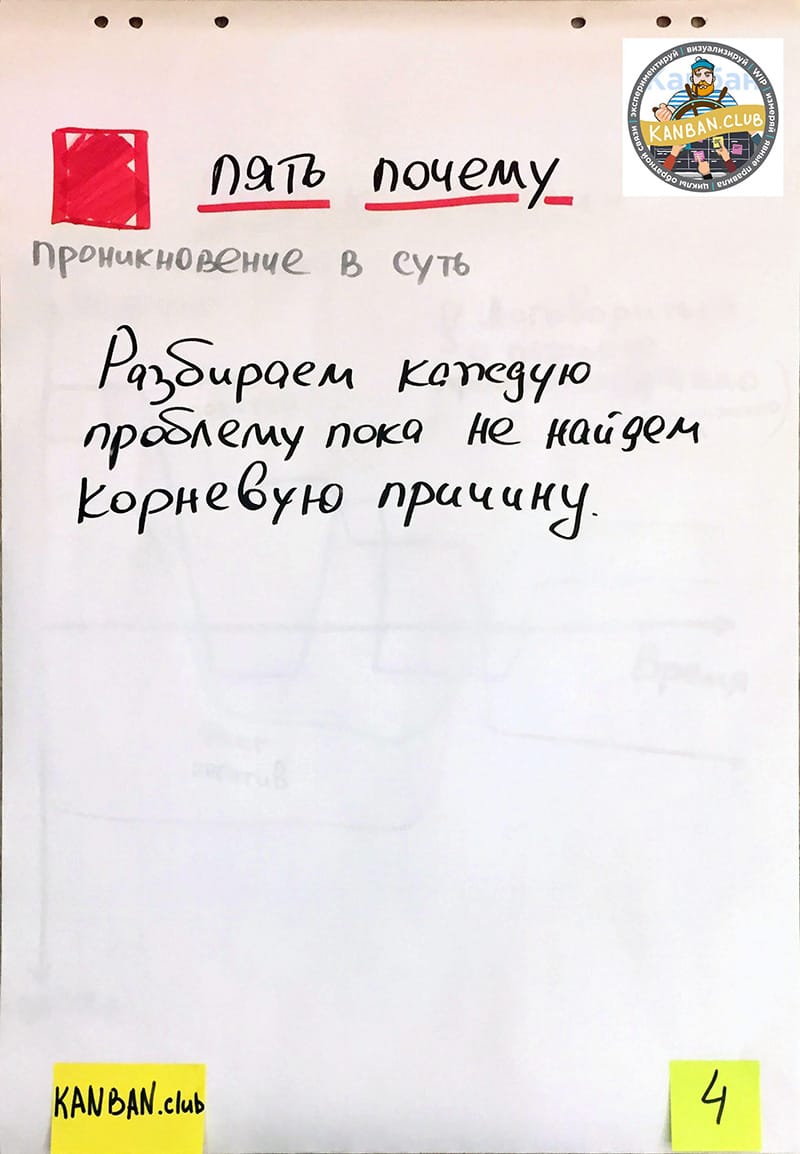
- Собираем все негативные факты, что удалось собрать на предыдущем этапе и клеим их в один вертикальный ряд
- Делим участников на группы по 3 человека:
- кол-во участников делим на 3.
- Округляем до целого в меньшую сторону.
- Просим по порядку рассчитаться от 1 до вычисленного числа.
- Указываем группе места, где с каким номером нужно собраться людям с одинаковым номером
- По каждому факту (сверху вниз), нам нужно понять корневую причину. Этим займутся группы. 3 минуты на написание одной корневой причины от группы на стикер.
- Фасилитатор составляет таблицу со столбцами Номер, Факт, Корневая причина, Решение, Ответственный, Срок выполнения.
- Представитель от каждой группы выходит к таблице и на группу рассказывает, какую они корневую причину возникновения данного факта нашли. После этого клеит стикер в строку соответствующего факта. Выслушиваем представителей от всех групп. Фасилитатор допускает дискуссию только между выступающим и один из представителей группы. Лучше придерживаться формата уточняющего вопроса.
1+1 = 1 (Генерация идей)
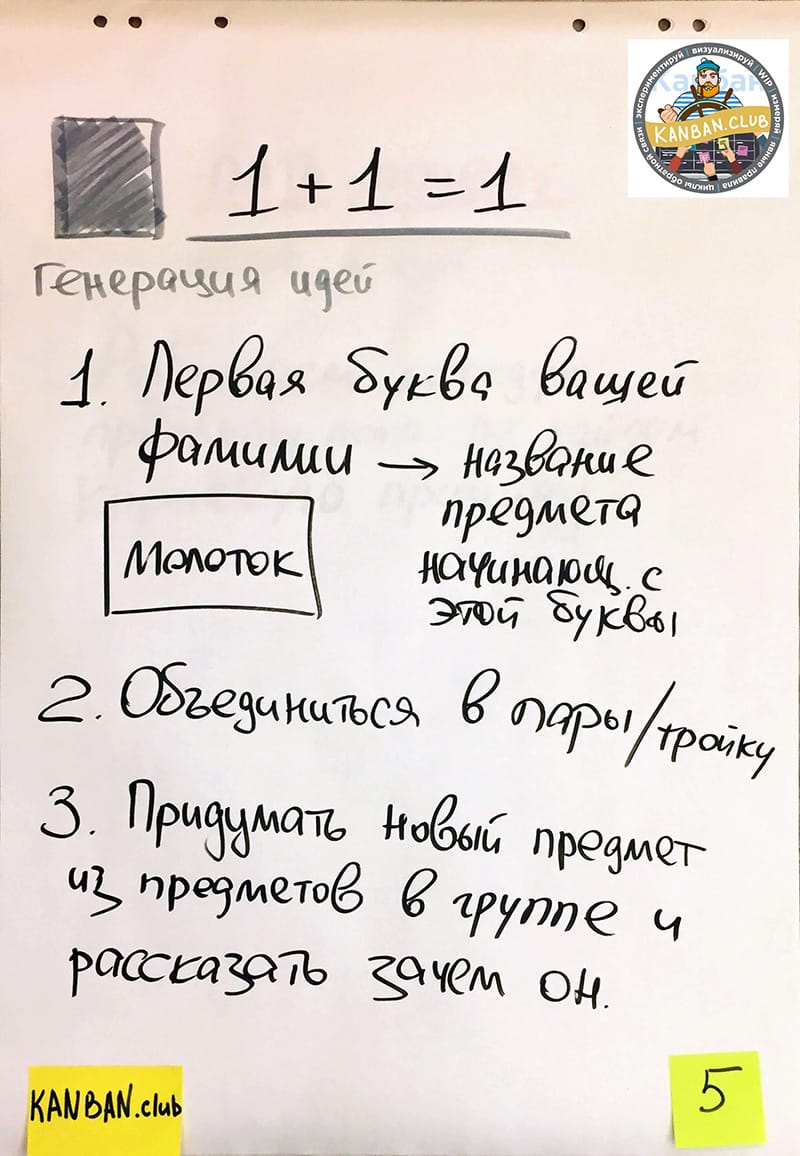
Прежде чем начать придумывать решения, нам нужно прогреть нейросеть участников в направлении креатива. Для этого предлагается использовать упражнение 1+1=1. Метафора такая: если мы соединим одну каплю с другой, то в результате у нас будет не две капли, а одна.
- Просим участников взять по одному стикеру
- Каждый в тайне друг от друга пишет название предмета, которое начинается с первой буквы его имени
- Находит себе пару, лучше чтобы это был не сосед
- За 1 минуту, каждая пара должна придумать, что за предмет у них получится, если объединить те, что записаны у них на стикерах, а так же придумать ситуацию где и как это можно использовать
- один из представителей пары рассказывает на всю группу, что получилось
Brainstorm (разработка плана)
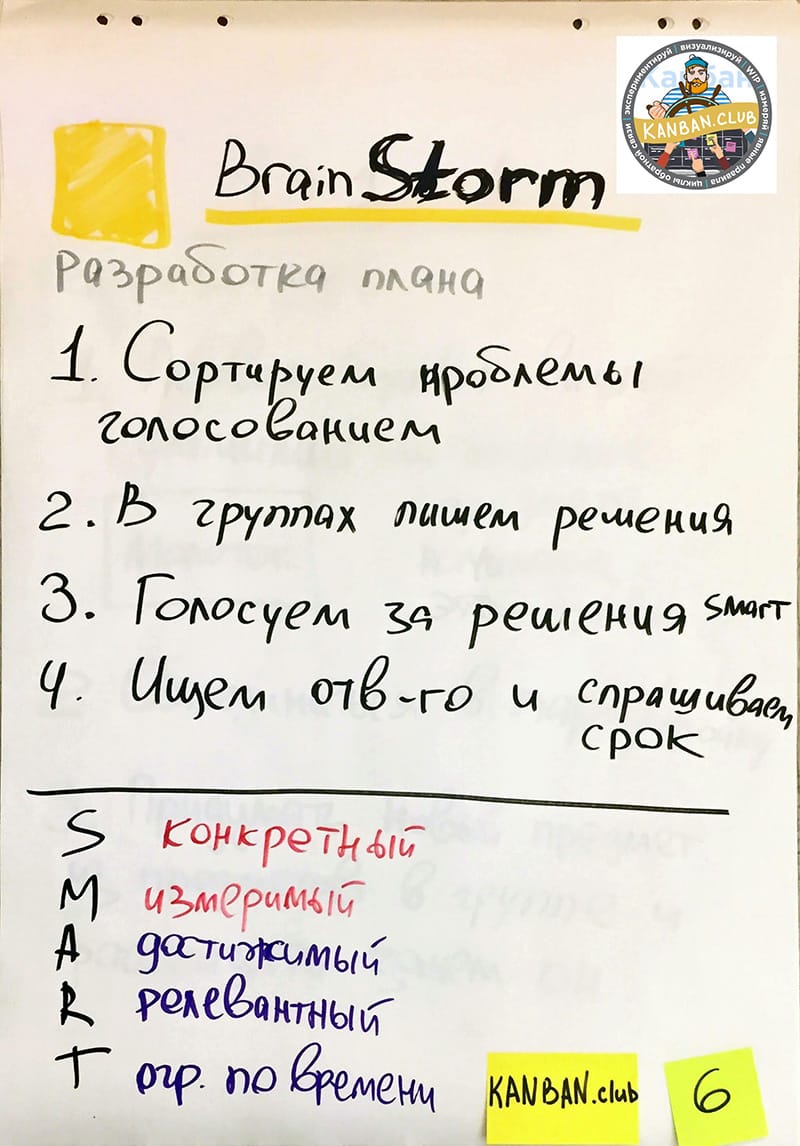
- Проводим голосование группы за карточки с фактами. Каждый участник ставит не более 3-х точек за карточки, которые для него наиболее важные. Один человек может поставить только одну точку на одну карточку
- Подсчитываем голоса и сортируем их по убыванию в нашей таблице.
- Договариваемся с группой, сколько проблем мы хотим разобрать на сегодняшней ретроспективе с учетом оставшегося времени
- По каждой проблеме, в тех же группа за 3 минуты придумываем, обсуждаем и записываем на стикеры решения, которые помогут решить соответствующую проблему. Фасилитатор помнит, что участники пишут одно решение на одном стикере и открывают стикеры в блок или вниз, чтобы не топорщились прикленными. Количество предлагаемых решений — ограничено здравым смыслом
- Представитель каждой группы выходит и выклеивает все найденные решения, группа может задавать уточняющие вопросы
- После того, как все выступят, фасилитатор задает вопрос группе: «Хочет ли кто-то взять на себя ответственность за какое-либо решение?»
- Если доброволец найден, спрашиваем какое решение он/а готов на себя взять, рядом с этим решением записываем его Имя и Фамилию и срок, когда он это сделает
- Если не найден, то спросить группу почему они не хотят брать на себя ответственность, возможно это, либо низкая зрелость группы и тут нужна помощь Лидера группы (это может быть скрам-мастер, владелец продукта, мастер потока и т. д.), либо решение лежит вне зоны контроля или влияния команды и ее нужно эскалировать наверх (договориться, кто это сделает)
- Решение может быть коллективным и бессрочным. Какая-то хорошая практика (всегда читать полностью задачу, заносить все в Jira и т. д.). В этом случае применяем упражнение Римское голосование. Спрашиваем группу: все ли готовы выполнять новую практику. Палец вверх — я согласен, Палец горизонтально — я соглашусь с большинством, Палец вниз — я не согласен. Если несогласных нет — то решение принимается, а иначе нет и переходим к следующему пункту.
- Смотрим на время, если до конца ретро осталось меньше 15 минут, то переходим к следующем этапу, если больше, то берем следующий по важности вопрос и прорабатываем уже его.
Ретро ретро (закрытие)

Ретро, как и любая другая активность нуждается в улучшении и подстройке под каждую конкретную команду. Фасилитатору это помогает подбирать соответствующие упражнения для группы. Кто-то отказывается от разминок, кто-то просит в следующий раз чего-нибудь новенького и т. д. Каждая команда уникальна.
Ну и конечно, это в каком-то виде обратная связь от группы к проведенному мероприятию
Спасибки (закрытие)
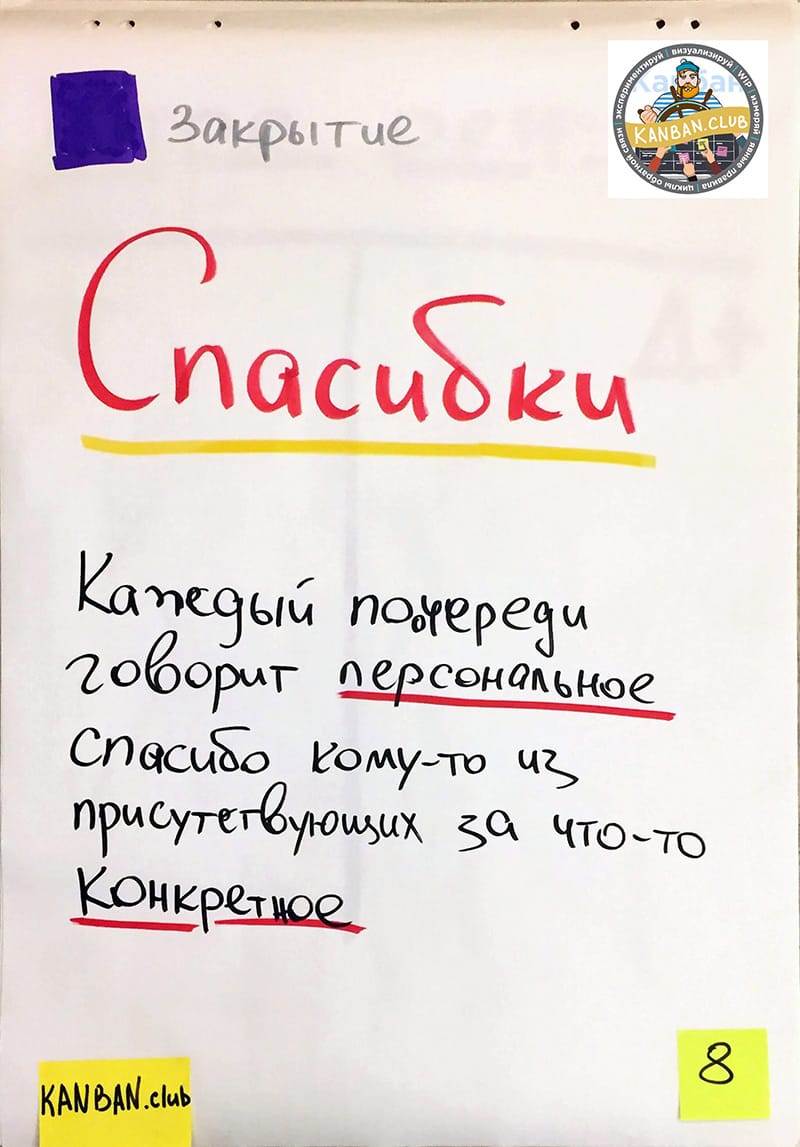
Открытие, как и закрытие ретроспективы должно проходить на сильных позитивных эмоциях, которые сплочали бы команду. На этом упражнении не должно быть дискуссии. Каждый по очереди говорит кому конкретно он хочет сказать спасибо и за что. Фразы: «всей команде», «всем спасибо» — не годятся.
После того, как все воспользовались возможностью сказать Спасибо, все хлопают в ладоши и расходятся в хорошем настроении.
——
Друзья, успехов вам, в фасилитации ваших ретроспектив!
Activities and games for the middle portion of the Agile retrospective tackle the core purposes of the meeting. These activities help you review what happened in the work period and brainstorm ideas for improvements. Some activities incorporate both elements, while others focus on one or the other.
Agile retrospective games for review typically prompt participants to think back on the sprint work in a structured way. The Agile retrospective format for brainstorming generally seeks to spur creative problem solving.
Activity Name: Scrum Values
Objective or Stage: Review
Group Size: 5+
Time: Medium
Materials Needed: Whiteboard, paper, pens
Ease of Facilitation: Medium
Remind the group of the Scrum values: commitment, openness, focus, respect, and courage. Ask each participant to write how they feel the team performs on each value, on a scale of one to five (five being the best). Total the points for each value from all participants.
Then, in a second round, ask each person to order the values based on how well the team performs on each, again on a scale of one to five. This time, respondents can only award each numerical score one time. (In the first round, the team could score fives for both respect and focus, but in this round, one value would have to be a five and the other a four.) Again, total the points.
Map these scores on a radar chart, and divide a circle into five pie wedges. Label each wedge with a value. Then, mark scores in concentric circles from zero at the center, moving higher as you go outward. The outer edge is the highest score. Map scores from each round, overlaying one over the other. If there are large divergences in how the team scored a value between rounds, this could signal areas where the team is out of alignment and could benefit from discussion.
Activity Name: Lean Coffee
Objective or Stage: Review, brainstorm
Group Size: Any
Time: Medium
Materials Needed: Sticky notes, whiteboard, pens, timer
Ease of Facilitation: Medium
Jim Benson and Jeremy Lightsmith developed Lean Coffee as the lightest-possible structure for a productive meeting. The name refers to Lean thinking and a casual gathering, such as over coffee.
Create a Kanban board with columns labeled To-Do, Doing, Done, and Actions. The group members write one potential topic for discussion on each sticky note. If you want, you can provide a theme for the topics. Put all the topics in the To-Do column. Briefly go through them, and summarize the topic.
Participants vote on the topics. Give each person a certain number of dots to use, which represent their votes. Have participants put dots on the topics they want to discuss. (They can put all votes toward one topic if they wish.) Pick the topics that get the most votes and put them to the top of the To-Do column. Move the first one to the Doing column.
Put five minutes on the timer and discuss the topic. At the end of the session, ask people if they want to continue discussing the topic. They vote with thumbs up, thumbs down, or thumbs sideways. If the majority wants to continue, set the timer again for a shorter window. Repeat this cycle until the group loses interest in the topic and move the topic to the Done column. Bring the next highest card over to the Doing column.
As the meeting time winds down, ask the group for insights or actions from the discussion, and write these in the Actions column. Take a photo or record these ideas.
Activity Name: Well, Learned, Different, Puzzle
Objective or Stage: Review, brainstorm
Group Size: Any
Time: Medium
Materials Needed: Whiteboard, sticky notes, pens
Ease of Facilitation: Easy
On the whiteboard, designate four areas as follows: Went Well, What We Learned, What We Would Do Differently, and What Puzzles Us.
Ask the team to contribute ideas on sticky notes for each section by thinking back to the recently completed sprint. Discuss the results, and consider if any follow-up action would be helpful.
Activity Name: FLAT
Objective or Stage: Review
Group Size: 5+
Time: Medium
Materials Needed: Whiteboard, sticky notes, pens
Ease of Facilitation: Medium
Divide the board into four quadrants labeled Lessons, Future Direction, Accomplishments, and Thank You. Ask participants to write notes about what they learned, what they are proud of, and how they plan to work in the future. You can also use this time to thank team members who made important contributions.
Give participants some time to think and write their notes. Post them in the right section of the board. When everyone is done, discuss and share reflections.
Activity Name: Error Conversation
Objective or Stage: Review, brainstorm
Group Size: Any
Time: Medium, long
Materials Needed: Whiteboard, sticky notes, pens
Ease of Facilitation: Medium
Ask team members to write down every mistake that occurred in the sprint, each on its own sticky note. Draw two columns on the board, labeled Errors of Commission (those that happened through action) and Errors of Omission (those that occurred as a result of inaction).
Ask each person to share an error, put it in the appropriate column, and discuss it briefly. Group similar mistakes together, and seek solutions and actions to address them. Reserve this activity for a mature team that feels comfortable admitting mistakes, and make sure that no individual feels targeted or attacked.
Activity Name: Good, Bad, and Ugly
Objective or Stage: Review, brainstorm
Group Size: Any
Time: Medium, long
Materials Needed: Whiteboard, sticky notes, pens
Ease of Facilitation: Easy, medium
Mark three sections on the board labeled Good (practices that are working well), Bad (things that should be eliminated), and Ugly (areas for improvement). Ask participants to write on sticky notes items that belong in each category. Discuss and identify action plans for the bad and the ugly.
Activity Name: Pain vs. Gain (or Pleasure and Gain)
Objective or Stage: Review
Group Size: 5+
Time: Medium
Materials Needed: Whiteboard, sticky notes, pens
Ease of Facilitation: Easy, medium
On the whiteboard, draw intersecting vertical and horizontal lines so that you have four quadrants. Label the top of the vertical line Pleasure and the bottom Pain. Label the far right of the horizontal line Gain and the far left Loss. Tell participants to write on individual sticky notes the tasks and work they handle on the project.
Give the team 10 minutes to work, and then ask people to put their sticky notes on the graph. Explain that the upper-right quadrant is often called the “magic quadrant” because it encompasses items that score highly on both spectrums. In this activity, that quadrant is for work that offers both pleasure and gain, meaning it is both enjoyable and productive — in other words, work that the group should prioritize.
In the bottom-right quadrant, work delivers gains but is not enjoyable. The team needs to keep doing this work because it contributes to the project. That said, ask for ideas on how these tasks can become more enjoyable. Note any action items.
Activities in the upper-left quadrant are enjoyable but do not contribute to larger gains. Ask the group to consider ways to make these gainful. If that is not possible, discontinue this work.
Work in the bottom left is painful and doesn’t contribute. Stop doing these activities. Discuss why they arose in the first place and if something changed from their original intention.
Activity Name: Is-Is Not, Does-Does Not
Objective or Stage: Review
Group Size: Any
Time: Medium
Materials Needed: Whiteboard, sticky notes, pens
Ease of Facilitation: Medium
Divide the whiteboard into four quadrants, and label them Is, Is Not, Does, and Does Not. Prompt the group to write characteristics about the team that fit into each quadrant, one per sticky note.
Participants can write notes that they want to be part of the team’s culture, such as, “The team is accountable to one another” or “The team does put customers first.” Alternatively, they can note shortcomings such as, “The team does not take deadlines seriously.”
Once everyone has posted their notes in the right spot, review them one by one and discuss.
Activity Name: Health Check
Objective or Stage: Review
Group Size: 8-10
Time: Medium, long
Materials Needed: Paper, pens
Ease of Facilitation: Difficult
Spotify, the company that originated this game, offers detailed directions and downloadable facilitation cards.
Identify key aspects of quality teams in your organization (Spotify uses 11 aspects, including learning, teamwork, speed, and fun). Then, discuss how the company is performing on each of the attributes. Ask participants to rate the team as red (poor results), green (great results), or yellow (somewhere in between.)
Once you’ve reached a consensus, fill out a chart that lists the attributes on rows and has columns for dates. Put a dot of the correct color in each row under the date, based on the results of the meeting. You can also add an arrow for a trend (for example, green with a down arrow would mean performance is great but deteriorating).
Perform this activity periodically to spot areas where the team is struggling and to identify trends. If you manage multiple teams, look at health check visualizations for all of the teams to gain a quick sense of how they are doing.
Remember to emphasize that this self-assessment activity is for the benefit of the team, not an evaluation tool for management. The health check only has value if the team is honest and believes the organization uses the tool in good faith.
Activity Name: KonMari Retrospective
Objective or Stage: Review
Group Size: Any
Time: Medium
Materials Needed: Whiteboard, pens, sticky notes
Ease of Facilitation: Medium
Based on the techniques of Japanese organizing expert Marie Kondo, this activity asks participants to identify team practices that belong in three categories: Spark Joy, Recycle, and Throw Away.
Divide your whiteboard into these three areas and have participants write notes for all the categories. Ask each team member to read their notes aloud and post them on the board. Then discuss any patterns or surprises, as well as any actions the notes suggest.
Activity Name: True North
Objective or Stage: Brainstorm
Group Size: Any
Time: Medium, long
Materials Needed: Whiteboard
Ease of Facilitation: Medium, difficult
Ask participants to describe what “true north” (achieving all goals) means for the team. Prompt the discussion by saying, “Suppose by some miracle all our obstacles disappeared and all problems were solved. What would that look like? How would things change?”
Once the team has established what the “true north” ideal looks like, ask participants to rate where the group is now between zero and 10, with 10 being that perfect state. Ask participants to name practices and norms that are currently working, and list them on the board.
Then, have participants brainstorm how the team could move one step closer to a 10 using the resources currently available. List those and prioritize the most popular suggestions for action.
Activity Name: Letter to the Future
Objective or Stage: Brainstorm
Group Size: Any
Time: Medium, long
Materials Needed: Paper, pens
Ease of Facilitation: Medium
Instruct participants to think about the team’s work and a colleague, subordinate, or boss who they would like to write a letter to in the future. Then, ask them to compose a short letter, imagining a future self. The topic should be something in the context of the team’s work or the organization, but beyond that, there are no restrictions.
After giving the group some time to write the letters, gather everyone back together. Ask each person to read their letter aloud. Discuss the ideas they raise and see if they spur any insights into the work.
Activity Name: Well, Not So Well, New Ideas
Objective or Stage: Review, brainstorm
Group Size: Any
Time: Short, medium
Materials Needed: Whiteboard, sticky notes, pens
Ease of Facilitation: Easy
Draw three columns on the whiteboard, and label them Well, Not So Well, and New Ideas. Explain to participants that they should write on sticky notes what went well and not so well during the retrospective, along with suggestions and potential improvements for the next sprint. Discuss the responses and prioritize follow-up actions.
Activity Name: Open the Box
Objective or Stage: Review, brainstorm
Group Size: Any
Time: Medium
Materials Needed: Whiteboard, sticky notes, pens
Ease of Facilitation: Medium
Draw a box in the center of the whiteboard. Around it designate three areas: things that the team should add to the box, things they should remove, and things already in the box that the team should keep.
Have participants think back on the sprint and write on sticky notes ideas for each section. Have them put their notes in the right spot on the board and explain them. Discuss and develop follow-up actions.
Activity Name: Marginal Wins
Objective or Stage: Brainstorming
Group Size: Any
Time: Medium, long
Materials Needed: Whiteboard, sticky notes, pen
Ease of Facilitation: Medium, difficult
Set the stage by explaining that transforming a process by 100 percent is challenging, but that generating 1 percent improvement on 100 things is far more doable. Tell the team that the point of the activity is to identify these quick wins — small changes that are easy to implement and bring incremental benefits.
Ask the group to brainstorm some small process improvements and write the suggestions on sticky notes. Put them on the board and discuss.
Activity Name: Known Issues
Objective or Stage: Brainstorm
Group Size: Any
Time: Medium
Materials Needed: Whiteboard, sticky notes, pens
Ease of Facilitation: Medium
Use this activity when you have already identified problems or haven’t had enough time to talk through solutions. Divide the group into small teams and instruct each team to write down the known problems the team faces. Group similar ones together on the board.
Then, tell participants to think about solutions to the issues. Write these ideas on sticky notes of a different color, and place the solutions next to the related problem. Discuss which are likely to be most effective and assign those.
Activity Name: Hot Air Balloon
Objective or Stage: Review, brainstorm
Group Size: Any
Time: Medium
Materials Needed: Whiteboard, sticky notes
Ease of Facilitation: Medium
Draw a hot air balloon with sandbags on the side. Above the balloon, sketch storm clouds on one side and a full sun on another. Explain to the group that their work together is like piloting a hot air balloon.
Ask participants to write down ideas on sticky notes in the following categories:
- Hot air buoys the balloon and helps it move forward.
- Sandbags weigh the group down.
- Storm clouds are risks and obstacles ahead.
- Sunshine represents opportunities and positive things in the future.
Have individuals put their notes in the appropriate area on the board and explain them to the group. Group similar ideas together, and discuss solutions to some of the common themes. Create actions for implementation.
Activity Name: Race Car
Objective or Stage: Review, brainstorm
Group Size: Any
Time: Medium
Materials Needed: Whiteboard, sticky notes, pens
Ease of Facilitation: Medium
Put a picture or drawing of a race car on the board. Label the front of the car as Engine and label another area near the wheels as Flat Tire. Ask the group to write on sticky notes what drives work forward (engines) and what holds it back or presents obstacles (flat tires). Discuss the findings and brainstorm solutions.
Activity Name: WWW (Worked Well, Kinda Worked, Didn’t Work)
Objective or Stage: Review, brainstorm
Group Size: Any
Time: Medium
Materials Needed: Whiteboard, sticky notes, pens, markers
Ease of Facilitation: Easy
Draw three columns on the whiteboard, and label them Worked Well, Kinda Worked, and Didn’t Work. Tell participants to write down notes from the sprint that fall into each of these categories. Then, put the responses in the appropriate column. Discuss and prioritize follow-up actions.
Activity Name: FLAP
Objective or Stage: Review, brainstorm
Group Size: Any
Time: Medium, long
Materials Needed: Whiteboard, sticky notes, pens
Ease of Facilitation: Medium
Label four boxes on the whiteboard: Future Considerations (focus areas for the next sprint), Lessons Learned (critical takeaways), Accomplishments (notable achievements), and Problems (things that need solutions). Ask participants to write sticky notes for each category. Discuss the team’s ideas.
Activity Name: FMEA (Failure Modes and Effects Analysis)
Objective or Stage: Review, brainstorm
Group Size: Any
Time: Long
Materials Needed: None
Ease of Facilitation: Difficult
The U.S. military developed this activity, which focuses on the different ways processes and systems can fail. To try the technique, use this FMEA template.
Download FMEA Template — Microsoft Excel
First, have the team brainstorm process pieces that need improvement. Then, for each, think about ways the process can go wrong, the impact of those failures, potential causes, severity, priority, and actions to address the issue.
Activity Name: Repeat/Avoid
Objective or Stage: Review, brainstorm
Group Size: Any
Time: Short, medium, long
Materials Needed: Whiteboard, sticky notes, pens
Ease of Facilitation: Medium
Divide the board in half, and label the two sides Repeat and Avoid. Then, ask the group to think of work, processes, and norms that the team should continue or repeat, and those that it should avoid and eliminate. Discuss and identify follow-up actions.
Activity Name: Drop, Keep, Add, Improve (DAKI)
Objective or Stage: Review, brainstorm
Group Size: Any
Time: Medium
Materials Needed: Whiteboard, sticky notes, pens
Ease of Facilitation: Medium
Draw four quadrants on the whiteboard, and label them as Drop, Add, Keep, and Improve. Ask participants to think back on the sprint and write on sticky notes any practices, processes, and attitudes that belong in each quadrant. Discuss the responses and develop follow-up actions.
Activity Name: Big Wins
Objective or Stage: Review
Group Size: 4+
Time: Short, medium
Materials Needed: Index cards
Ease of Facilitation: Easy
Give each participant two index cards. Have each person write their name on the first card, and collect these. On the second card, have the participants write their “big win” of the recent work or sprint and conceal the card.
Distribute the name cards so that no one gets their own. Everyone writes what they think the “big win” was for the person whose name they receive. Go around the room and have everyone present their guesses. The named person reveals the right answer to see if they match.
This activity provides good discussion material whether answers match or not. When they do, talk about how the guesser knew about the person’s sense of achievement and the role of empathy on teams. For mismatches, discuss communication and building awareness.
Activity Name: Problems and Actions
Objective or Stage: Review, brainstorm
Group Size: Any
Time: Medium
Materials Needed: Whiteboard, sticky notes
Ease of Facilitation: Easy, medium
Have participants write down any problems they see in the team’s processes (one issue per sticky note). Put these issues on the whiteboard in a column named Problems. Title another column next to it Actions, and ask participants to note down any solutions or actions that could address the problem.
Set a time limit for the exercise (usually 25 to 30 minutes). Then, prioritize action items for implementation.
Activity Name: Rose, Bud, and Thorn
Objective or Stage: Review
Group Size: Any
Time: Medium
Materials Needed: Whiteboard, sticky notes
Ease of Facilitation: Medium
Divide the board into three sections titled Rose, Thorn, and Bud. Ask team members to write highlights and success factors in the Rose space. Challenges go under Thorn, and the Bud section covers opportunities for growth and improvement.
Go through the responses together. Recognize the roses, discuss ways to make the most of buds, and seek solutions to thorns.
Activity Name: Genie in a Bottle
Objective or Stage: Review, brainstorm
Group Size: Any
Time: Medium, long
Materials Needed: Whiteboard, sticky notes
Ease of Facilitation: Medium, difficult
Begin by asking participants to name positive developments and dimensions of the work period. You can prompt them with questions such as: What worked well? What did you like? What were you proud of? What did someone else do that made a positive impact?
Have the group record their thoughts on sticky notes and post them. Review them together. This lays the groundwork for the next part of the activity.
Next, tell the group to imagine they find a magic bottle. They open the bottle and a genie materializes, who grants each team member three wishes: one for themselves, one for the team, and one for the world.
Let the team think for 10 minutes, then write their three wishes on sticky notes with a bit of explanation. Group similar items together on the board. Tell participants to vote on the wishes they want to discuss. Discuss the wishes that received the most votes. Ask the group what, if anything, the team is already doing to help realize the wishes. In addition, ask them to brainstorm what else the team could do to support the wishes.
Determine action items that the team can implement in the next sprint.
Activity Name: WRAP
Objective or Stage: Review, brainstorm
Group Size: Any
Time: Medium, long
Materials Needed: Whiteboard, sticky notes
Ease of Facilitation: Medium
Draw four quadrants on the whiteboard. Label these Wishes (desired changes and outcomes), Risks (threats to project success), Appreciations (recognizing helpful people and contributions), and Puzzles (questions about the work). Have participants reflect on the sprint and jot down practices, processes, and attitudes that belong in each quadrant. Discuss the responses and develop follow-up actions.
Activity Name: Sharks and Chimps
Objective or Stage: Review
Group Size: 5+
Time: Medium
Materials Needed: None
Ease of Facilitation: Medium
Ask participants to nominate teammates as “sharks” for effective action and cool efficiency during the sprint. Each nominator details the ways in which the proposed shark contributed. From the nominations, everyone votes on a winner. You can award a prize, such as a toy shark the winner gets to display for the next sprint. The activity promotes an appreciation habit.
Then, have participants nominate themselves as “chimps” for mistakes or stumbles during the sprint. They explain what went wrong and what they learned. The team votes for the best chimp story, and the winner gets a small prize. The benefit of the activity is to make people more comfortable talking about failure and the ways a team can learn from it.
Activities and games for the middle portion of the Agile retrospective tackle the core purposes of the meeting. These activities help you review what happened in the work period and brainstorm ideas for improvements. Some activities incorporate both elements, while others focus on one or the other.
Agile retrospective games for review typically prompt participants to think back on the sprint work in a structured way. The Agile retrospective format for brainstorming generally seeks to spur creative problem solving.
Activity Name: Scrum Values
Objective or Stage: Review
Group Size: 5+
Time: Medium
Materials Needed: Whiteboard, paper, pens
Ease of Facilitation: Medium
Remind the group of the Scrum values: commitment, openness, focus, respect, and courage. Ask each participant to write how they feel the team performs on each value, on a scale of one to five (five being the best). Total the points for each value from all participants.
Then, in a second round, ask each person to order the values based on how well the team performs on each, again on a scale of one to five. This time, respondents can only award each numerical score one time. (In the first round, the team could score fives for both respect and focus, but in this round, one value would have to be a five and the other a four.) Again, total the points.
Map these scores on a radar chart, and divide a circle into five pie wedges. Label each wedge with a value. Then, mark scores in concentric circles from zero at the center, moving higher as you go outward. The outer edge is the highest score. Map scores from each round, overlaying one over the other. If there are large divergences in how the team scored a value between rounds, this could signal areas where the team is out of alignment and could benefit from discussion.
Activity Name: Lean Coffee
Objective or Stage: Review, brainstorm
Group Size: Any
Time: Medium
Materials Needed: Sticky notes, whiteboard, pens, timer
Ease of Facilitation: Medium
Jim Benson and Jeremy Lightsmith developed Lean Coffee as the lightest-possible structure for a productive meeting. The name refers to Lean thinking and a casual gathering, such as over coffee.
Create a Kanban board with columns labeled To-Do, Doing, Done, and Actions. The group members write one potential topic for discussion on each sticky note. If you want, you can provide a theme for the topics. Put all the topics in the To-Do column. Briefly go through them, and summarize the topic.
Participants vote on the topics. Give each person a certain number of dots to use, which represent their votes. Have participants put dots on the topics they want to discuss. (They can put all votes toward one topic if they wish.) Pick the topics that get the most votes and put them to the top of the To-Do column. Move the first one to the Doing column.
Put five minutes on the timer and discuss the topic. At the end of the session, ask people if they want to continue discussing the topic. They vote with thumbs up, thumbs down, or thumbs sideways. If the majority wants to continue, set the timer again for a shorter window. Repeat this cycle until the group loses interest in the topic and move the topic to the Done column. Bring the next highest card over to the Doing column.
As the meeting time winds down, ask the group for insights or actions from the discussion, and write these in the Actions column. Take a photo or record these ideas.
Activity Name: Well, Learned, Different, Puzzle
Objective or Stage: Review, brainstorm
Group Size: Any
Time: Medium
Materials Needed: Whiteboard, sticky notes, pens
Ease of Facilitation: Easy
On the whiteboard, designate four areas as follows: Went Well, What We Learned, What We Would Do Differently, and What Puzzles Us.
Ask the team to contribute ideas on sticky notes for each section by thinking back to the recently completed sprint. Discuss the results, and consider if any follow-up action would be helpful.
Activity Name: FLAT
Objective or Stage: Review
Group Size: 5+
Time: Medium
Materials Needed: Whiteboard, sticky notes, pens
Ease of Facilitation: Medium
Divide the board into four quadrants labeled Lessons, Future Direction, Accomplishments, and Thank You. Ask participants to write notes about what they learned, what they are proud of, and how they plan to work in the future. You can also use this time to thank team members who made important contributions.
Give participants some time to think and write their notes. Post them in the right section of the board. When everyone is done, discuss and share reflections.
Activity Name: Error Conversation
Objective or Stage: Review, brainstorm
Group Size: Any
Time: Medium, long
Materials Needed: Whiteboard, sticky notes, pens
Ease of Facilitation: Medium
Ask team members to write down every mistake that occurred in the sprint, each on its own sticky note. Draw two columns on the board, labeled Errors of Commission (those that happened through action) and Errors of Omission (those that occurred as a result of inaction).
Ask each person to share an error, put it in the appropriate column, and discuss it briefly. Group similar mistakes together, and seek solutions and actions to address them. Reserve this activity for a mature team that feels comfortable admitting mistakes, and make sure that no individual feels targeted or attacked.
Activity Name: Good, Bad, and Ugly
Objective or Stage: Review, brainstorm
Group Size: Any
Time: Medium, long
Materials Needed: Whiteboard, sticky notes, pens
Ease of Facilitation: Easy, medium
Mark three sections on the board labeled Good (practices that are working well), Bad (things that should be eliminated), and Ugly (areas for improvement). Ask participants to write on sticky notes items that belong in each category. Discuss and identify action plans for the bad and the ugly.
Activity Name: Pain vs. Gain (or Pleasure and Gain)
Objective or Stage: Review
Group Size: 5+
Time: Medium
Materials Needed: Whiteboard, sticky notes, pens
Ease of Facilitation: Easy, medium
On the whiteboard, draw intersecting vertical and horizontal lines so that you have four quadrants. Label the top of the vertical line Pleasure and the bottom Pain. Label the far right of the horizontal line Gain and the far left Loss. Tell participants to write on individual sticky notes the tasks and work they handle on the project.
Give the team 10 minutes to work, and then ask people to put their sticky notes on the graph. Explain that the upper-right quadrant is often called the “magic quadrant” because it encompasses items that score highly on both spectrums. In this activity, that quadrant is for work that offers both pleasure and gain, meaning it is both enjoyable and productive — in other words, work that the group should prioritize.
In the bottom-right quadrant, work delivers gains but is not enjoyable. The team needs to keep doing this work because it contributes to the project. That said, ask for ideas on how these tasks can become more enjoyable. Note any action items.
Activities in the upper-left quadrant are enjoyable but do not contribute to larger gains. Ask the group to consider ways to make these gainful. If that is not possible, discontinue this work.
Work in the bottom left is painful and doesn’t contribute. Stop doing these activities. Discuss why they arose in the first place and if something changed from their original intention.
Activity Name: Is-Is Not, Does-Does Not
Objective or Stage: Review
Group Size: Any
Time: Medium
Materials Needed: Whiteboard, sticky notes, pens
Ease of Facilitation: Medium
Divide the whiteboard into four quadrants, and label them Is, Is Not, Does, and Does Not. Prompt the group to write characteristics about the team that fit into each quadrant, one per sticky note.
Participants can write notes that they want to be part of the team’s culture, such as, “The team is accountable to one another” or “The team does put customers first.” Alternatively, they can note shortcomings such as, “The team does not take deadlines seriously.”
Once everyone has posted their notes in the right spot, review them one by one and discuss.
Activity Name: Health Check
Objective or Stage: Review
Group Size: 8-10
Time: Medium, long
Materials Needed: Paper, pens
Ease of Facilitation: Difficult
Spotify, the company that originated this game, offers detailed directions and downloadable facilitation cards.
Identify key aspects of quality teams in your organization (Spotify uses 11 aspects, including learning, teamwork, speed, and fun). Then, discuss how the company is performing on each of the attributes. Ask participants to rate the team as red (poor results), green (great results), or yellow (somewhere in between.)
Once you’ve reached a consensus, fill out a chart that lists the attributes on rows and has columns for dates. Put a dot of the correct color in each row under the date, based on the results of the meeting. You can also add an arrow for a trend (for example, green with a down arrow would mean performance is great but deteriorating).
Perform this activity periodically to spot areas where the team is struggling and to identify trends. If you manage multiple teams, look at health check visualizations for all of the teams to gain a quick sense of how they are doing.
Remember to emphasize that this self-assessment activity is for the benefit of the team, not an evaluation tool for management. The health check only has value if the team is honest and believes the organization uses the tool in good faith.
Activity Name: KonMari Retrospective
Objective or Stage: Review
Group Size: Any
Time: Medium
Materials Needed: Whiteboard, pens, sticky notes
Ease of Facilitation: Medium
Based on the techniques of Japanese organizing expert Marie Kondo, this activity asks participants to identify team practices that belong in three categories: Spark Joy, Recycle, and Throw Away.
Divide your whiteboard into these three areas and have participants write notes for all the categories. Ask each team member to read their notes aloud and post them on the board. Then discuss any patterns or surprises, as well as any actions the notes suggest.
Activity Name: True North
Objective or Stage: Brainstorm
Group Size: Any
Time: Medium, long
Materials Needed: Whiteboard
Ease of Facilitation: Medium, difficult
Ask participants to describe what “true north” (achieving all goals) means for the team. Prompt the discussion by saying, “Suppose by some miracle all our obstacles disappeared and all problems were solved. What would that look like? How would things change?”
Once the team has established what the “true north” ideal looks like, ask participants to rate where the group is now between zero and 10, with 10 being that perfect state. Ask participants to name practices and norms that are currently working, and list them on the board.
Then, have participants brainstorm how the team could move one step closer to a 10 using the resources currently available. List those and prioritize the most popular suggestions for action.
Activity Name: Letter to the Future
Objective or Stage: Brainstorm
Group Size: Any
Time: Medium, long
Materials Needed: Paper, pens
Ease of Facilitation: Medium
Instruct participants to think about the team’s work and a colleague, subordinate, or boss who they would like to write a letter to in the future. Then, ask them to compose a short letter, imagining a future self. The topic should be something in the context of the team’s work or the organization, but beyond that, there are no restrictions.
After giving the group some time to write the letters, gather everyone back together. Ask each person to read their letter aloud. Discuss the ideas they raise and see if they spur any insights into the work.
Activity Name: Well, Not So Well, New Ideas
Objective or Stage: Review, brainstorm
Group Size: Any
Time: Short, medium
Materials Needed: Whiteboard, sticky notes, pens
Ease of Facilitation: Easy
Draw three columns on the whiteboard, and label them Well, Not So Well, and New Ideas. Explain to participants that they should write on sticky notes what went well and not so well during the retrospective, along with suggestions and potential improvements for the next sprint. Discuss the responses and prioritize follow-up actions.
Activity Name: Open the Box
Objective or Stage: Review, brainstorm
Group Size: Any
Time: Medium
Materials Needed: Whiteboard, sticky notes, pens
Ease of Facilitation: Medium
Draw a box in the center of the whiteboard. Around it designate three areas: things that the team should add to the box, things they should remove, and things already in the box that the team should keep.
Have participants think back on the sprint and write on sticky notes ideas for each section. Have them put their notes in the right spot on the board and explain them. Discuss and develop follow-up actions.
Activity Name: Marginal Wins
Objective or Stage: Brainstorming
Group Size: Any
Time: Medium, long
Materials Needed: Whiteboard, sticky notes, pen
Ease of Facilitation: Medium, difficult
Set the stage by explaining that transforming a process by 100 percent is challenging, but that generating 1 percent improvement on 100 things is far more doable. Tell the team that the point of the activity is to identify these quick wins — small changes that are easy to implement and bring incremental benefits.
Ask the group to brainstorm some small process improvements and write the suggestions on sticky notes. Put them on the board and discuss.
Activity Name: Known Issues
Objective or Stage: Brainstorm
Group Size: Any
Time: Medium
Materials Needed: Whiteboard, sticky notes, pens
Ease of Facilitation: Medium
Use this activity when you have already identified problems or haven’t had enough time to talk through solutions. Divide the group into small teams and instruct each team to write down the known problems the team faces. Group similar ones together on the board.
Then, tell participants to think about solutions to the issues. Write these ideas on sticky notes of a different color, and place the solutions next to the related problem. Discuss which are likely to be most effective and assign those.
Activity Name: Hot Air Balloon
Objective or Stage: Review, brainstorm
Group Size: Any
Time: Medium
Materials Needed: Whiteboard, sticky notes
Ease of Facilitation: Medium
Draw a hot air balloon with sandbags on the side. Above the balloon, sketch storm clouds on one side and a full sun on another. Explain to the group that their work together is like piloting a hot air balloon.
Ask participants to write down ideas on sticky notes in the following categories:
- Hot air buoys the balloon and helps it move forward.
- Sandbags weigh the group down.
- Storm clouds are risks and obstacles ahead.
- Sunshine represents opportunities and positive things in the future.
Have individuals put their notes in the appropriate area on the board and explain them to the group. Group similar ideas together, and discuss solutions to some of the common themes. Create actions for implementation.
Activity Name: Race Car
Objective or Stage: Review, brainstorm
Group Size: Any
Time: Medium
Materials Needed: Whiteboard, sticky notes, pens
Ease of Facilitation: Medium
Put a picture or drawing of a race car on the board. Label the front of the car as Engine and label another area near the wheels as Flat Tire. Ask the group to write on sticky notes what drives work forward (engines) and what holds it back or presents obstacles (flat tires). Discuss the findings and brainstorm solutions.
Activity Name: WWW (Worked Well, Kinda Worked, Didn’t Work)
Objective or Stage: Review, brainstorm
Group Size: Any
Time: Medium
Materials Needed: Whiteboard, sticky notes, pens, markers
Ease of Facilitation: Easy
Draw three columns on the whiteboard, and label them Worked Well, Kinda Worked, and Didn’t Work. Tell participants to write down notes from the sprint that fall into each of these categories. Then, put the responses in the appropriate column. Discuss and prioritize follow-up actions.
Activity Name: FLAP
Objective or Stage: Review, brainstorm
Group Size: Any
Time: Medium, long
Materials Needed: Whiteboard, sticky notes, pens
Ease of Facilitation: Medium
Label four boxes on the whiteboard: Future Considerations (focus areas for the next sprint), Lessons Learned (critical takeaways), Accomplishments (notable achievements), and Problems (things that need solutions). Ask participants to write sticky notes for each category. Discuss the team’s ideas.
Activity Name: FMEA (Failure Modes and Effects Analysis)
Objective or Stage: Review, brainstorm
Group Size: Any
Time: Long
Materials Needed: None
Ease of Facilitation: Difficult
The U.S. military developed this activity, which focuses on the different ways processes and systems can fail. To try the technique, use this FMEA template.
Download FMEA Template — Microsoft Excel
First, have the team brainstorm process pieces that need improvement. Then, for each, think about ways the process can go wrong, the impact of those failures, potential causes, severity, priority, and actions to address the issue.
Activity Name: Repeat/Avoid
Objective or Stage: Review, brainstorm
Group Size: Any
Time: Short, medium, long
Materials Needed: Whiteboard, sticky notes, pens
Ease of Facilitation: Medium
Divide the board in half, and label the two sides Repeat and Avoid. Then, ask the group to think of work, processes, and norms that the team should continue or repeat, and those that it should avoid and eliminate. Discuss and identify follow-up actions.
Activity Name: Drop, Keep, Add, Improve (DAKI)
Objective or Stage: Review, brainstorm
Group Size: Any
Time: Medium
Materials Needed: Whiteboard, sticky notes, pens
Ease of Facilitation: Medium
Draw four quadrants on the whiteboard, and label them as Drop, Add, Keep, and Improve. Ask participants to think back on the sprint and write on sticky notes any practices, processes, and attitudes that belong in each quadrant. Discuss the responses and develop follow-up actions.
Activity Name: Big Wins
Objective or Stage: Review
Group Size: 4+
Time: Short, medium
Materials Needed: Index cards
Ease of Facilitation: Easy
Give each participant two index cards. Have each person write their name on the first card, and collect these. On the second card, have the participants write their “big win” of the recent work or sprint and conceal the card.
Distribute the name cards so that no one gets their own. Everyone writes what they think the “big win” was for the person whose name they receive. Go around the room and have everyone present their guesses. The named person reveals the right answer to see if they match.
This activity provides good discussion material whether answers match or not. When they do, talk about how the guesser knew about the person’s sense of achievement and the role of empathy on teams. For mismatches, discuss communication and building awareness.
Activity Name: Problems and Actions
Objective or Stage: Review, brainstorm
Group Size: Any
Time: Medium
Materials Needed: Whiteboard, sticky notes
Ease of Facilitation: Easy, medium
Have participants write down any problems they see in the team’s processes (one issue per sticky note). Put these issues on the whiteboard in a column named Problems. Title another column next to it Actions, and ask participants to note down any solutions or actions that could address the problem.
Set a time limit for the exercise (usually 25 to 30 minutes). Then, prioritize action items for implementation.
Activity Name: Rose, Bud, and Thorn
Objective or Stage: Review
Group Size: Any
Time: Medium
Materials Needed: Whiteboard, sticky notes
Ease of Facilitation: Medium
Divide the board into three sections titled Rose, Thorn, and Bud. Ask team members to write highlights and success factors in the Rose space. Challenges go under Thorn, and the Bud section covers opportunities for growth and improvement.
Go through the responses together. Recognize the roses, discuss ways to make the most of buds, and seek solutions to thorns.
Activity Name: Genie in a Bottle
Objective or Stage: Review, brainstorm
Group Size: Any
Time: Medium, long
Materials Needed: Whiteboard, sticky notes
Ease of Facilitation: Medium, difficult
Begin by asking participants to name positive developments and dimensions of the work period. You can prompt them with questions such as: What worked well? What did you like? What were you proud of? What did someone else do that made a positive impact?
Have the group record their thoughts on sticky notes and post them. Review them together. This lays the groundwork for the next part of the activity.
Next, tell the group to imagine they find a magic bottle. They open the bottle and a genie materializes, who grants each team member three wishes: one for themselves, one for the team, and one for the world.
Let the team think for 10 minutes, then write their three wishes on sticky notes with a bit of explanation. Group similar items together on the board. Tell participants to vote on the wishes they want to discuss. Discuss the wishes that received the most votes. Ask the group what, if anything, the team is already doing to help realize the wishes. In addition, ask them to brainstorm what else the team could do to support the wishes.
Determine action items that the team can implement in the next sprint.
Activity Name: WRAP
Objective or Stage: Review, brainstorm
Group Size: Any
Time: Medium, long
Materials Needed: Whiteboard, sticky notes
Ease of Facilitation: Medium
Draw four quadrants on the whiteboard. Label these Wishes (desired changes and outcomes), Risks (threats to project success), Appreciations (recognizing helpful people and contributions), and Puzzles (questions about the work). Have participants reflect on the sprint and jot down practices, processes, and attitudes that belong in each quadrant. Discuss the responses and develop follow-up actions.
Activity Name: Sharks and Chimps
Objective or Stage: Review
Group Size: 5+
Time: Medium
Materials Needed: None
Ease of Facilitation: Medium
Ask participants to nominate teammates as “sharks” for effective action and cool efficiency during the sprint. Each nominator details the ways in which the proposed shark contributed. From the nominations, everyone votes on a winner. You can award a prize, such as a toy shark the winner gets to display for the next sprint. The activity promotes an appreciation habit.
Then, have participants nominate themselves as “chimps” for mistakes or stumbles during the sprint. They explain what went wrong and what they learned. The team votes for the best chimp story, and the winner gets a small prize. The benefit of the activity is to make people more comfortable talking about failure and the ways a team can learn from it.
Ретроспектива проекта
Ретроспектива проекта – собрание, встреча команды после завершения какого-либо проекта для того, чтобы подвести итоги, поделиться полученным опытом и составить планы на будущее. Это всегда очень важный шаг для развития компании, который направлен на повышении результативности проектов и мотивацию участников.
Ритуал ретроспективы – это больше чем анализ прошедшего. Он позволяет также взглянуть вперед, представить следующий проект, и особенно тщательно проработать, что в следующий раз будет делаться по-другому.
Норм Керт (Norm Kerth)
Мы подводим итоги во всех сферах жизни. Работа над проектами в компаниях не является исключением. Но вот всегда ли этот процесс проходит правильно? Всегда ли заостряется внимание на положительных моментах работы над проектом?
Проведение ретроспективы помогает:
-
- увидеть необходимость постоянных улучшений в работе компании;
- замотивировать участников на достижение будущих целей;
- незаметно перенимать знания у незаменимых специалистов;
- развивать участников команды;
- управлять улучшениями и изменениями;
- управлять знаниями, пополнять их;
- повышать мастерство сотрудников;
Более того, с помощью ретроспективы проектов команда получает больше удовольствия от совместной работы, становится сильнее, повышает свой потенциал и продуктивность работы.
Фактически, ретроспектива проекта становится площадкой для “управляемой самостоятельности” – развивается культура обучения друг у друга. Кроме того, перед любого стартом нового проекта полезно будет вспоминать ошибки и выигрышные решения предыдущей работы.
Главное в этом мероприятии, чтобы оно стало регулярным. Этот инструмент станет действительно мощным, если его хорошо организовать и управлять им.
Важным человеком в проведении ретроспективы проекта является ведущий. Основные его задачи: инициировать и мониторить, контролировать безопасность и создавать условия, при которых у участников есть возможность быть честными. Не рекомендуется,чтобы ведущим был руководитель.
Команда может практиковать и метод “эстафетной палочки”, когда ведущий меняется от ретроспективы к ретроспективе.
Из дополнительных материалов вам понадобятся рулоны миллиметровки, флип чарт, разноцветные стикеры и маркеры.
Продолжительность ретроспективы выбираете вы сами. Для недельного проекта достаточно часа, для итогов месяца понадобится четыре часа, а более продолжительные проекты требуют более масштабного подведения итогов. К тому же, чем больше участников, тем более продолжительным будет мероприятие.
План проведения ретроспективы проекта:
1 шаг: определите цели ретроспективы
Цель должна ответить на вопрос: какую ценность мы должны получить, чтобы оправдать инвестицию времени?
Примерный список целей:
-
- как улучшить реализацию проектов?
- что в проекте было сделано хорошо?
- почему случались неудачи?
- как улучшить взаимоотношения в команде?
Самое важное – заинтересовать участников команды. Погрузите их в контекст мероприятия, расскажите о целях и задачах встречи, планируемом результате.
2 шаг: раздайте стикеры и маркеры
Раздайте сотрудникам цветные стикеры, маркеры и фломастеры. Они должны записать, что повлияло на этот проект из общественной и политической жизни, почему он стал именно таким. На это задание отводится 5-7 минут.
Шаг 3: обсудите ключевых людей
Вырежьте из стикеров человечков и в группах из 4-5 человек обсудите ключевых людей, которые повлияли на проект. На стикерах можно написать имя и должность сотрудника. На задание отводится 5-7 минут.
Шаг 4: нарисуйте линию времени
На большом листе бумаги нарисуйте линию времени, затем пусть сотрудники отметят успешные периоды, переломные моменты и ключевые события работы. Обсудите это всей командой.
Шаг 5: Зафиксируйте положительные и отрицательные моменты
Выдайте каждому сотруднику 7 стикеров одного цвета, где он укажет моменты работы над проектом, которые ему приятно вспоминать. Затем раздайте 7 стикеров другого цвета, на которых надо отметить, что их расстраивало в ходе проекта. Также обсудите моменты, которые были безумием.
Шаг 6: подведите итоги
Подготовьте 2 листа флип чарта. На одном будут отмечены моменты, которые сработали хорошо в предыдущем проекте. На втором пусть располагаются идеи, что следует делать иначе. Каждый сотрудник должен выдвинуть по пять идей для первого и второго листа. Полученные результаты обсудите.
О чем стоит помнить:
-
- Такой анализ надо проводить после каждого проекта;
- Материалы бесед становятся ресурсом долговременного и постоянного обучения и корпоративных традиций;
- Это самый рабочий способ создания корпоративной базы знаний;
- Хороший способ создать рабочую команду с общим фокусом;
- Ретроспектива проекта помогает вовлекать и мотивировать;
- И еще она фокусирует на процессе командного взаимодействия.
Читайте также:
-
- Обучение персонала: главные правила
- Планирование карьеры сотрудника
- Как вывести команду продавцов из кризиса? 7 рекомендаций
- Негативные отзывы и как с ними работать
- Как быстро и конструктивно подвести итоги
Ретроспектива (или просто ретро) — это специальная встреча, которая проводится по итогам одного или нескольких спринтов. На ней команда подводит итоги проделанной работы и рефлексирует о проведенном времени.
Ретроспектива — важный атрибут работы по гибким методологиям. Она помогает команде:
-
взглянуть на себя со стороны, оценить свою работу;
-
на ранней стадии выявить проблемы в коммуникации и сложности в рабочих процессах;
-
найти способы и составить план решения этих проблем;
-
сгенерировать идеи по улучшению рабочего процесса.
В общих чертах ретроспективу можно свести к обсуждению ответов на следующие вопросы:
-
Что было хорошего в прошедшем спринте? Что помогало работать?
-
Что мешало сотруднику в работе?
-
Что или кто может помочь ему работать лучше?
Основная цель ретроспективы — создать безопасное пространство для общения команды. На ней каждый участник может поделиться тревогами и проблемами. Выявление и решение проблем в перспективе должно повысить эффективность работы над проектом.
Этапы ретроспективы
Существует множество возможных сценариев встречи. «Классической» считается структура ретроспективы из пяти этапов.
-
Создание атмосферы. Ведущий ставит цели ретроспективы, обозначает тайминг и делится ожиданиями от встречи. Еще одна цель этого этапа — настроить участников встречи, «растопить лед» между ними и фасилитатором. Для этого можно проводить активности, не связанные с работой.
-
Сбор информации. Команда настроена на общение — время провести обзор прошедшей итерации, обсудить ключевые события. Важно, чтобы на этом этапе мог выговориться каждый.
-
Формирование понимания. Рефлексия. Участники либо напрямую делятся проблемами, либо выявляют их в процессе обсуждения. Далее можно переходить к генерации идей по их решению. Можно обращаться к разным методикам мозгового штурма.
-
Выработка плана действий. Участники решают, как можно улучшить рабочие процессы, чтобы решить найденные проблемы. Например, скорректировать бэклог, уменьшить число кругов проверки или декомпозировать задачи.
-
Завершение. Закрытие встречи: команда фиксирует все, к чему пришла в процессе. Команда выбирает, что будет применяться в работе со следующей итерации. Далее фасилитатор подводит итоги встречи, а участники благодарят его и друг друга за проведенное время.
Как проводить ретроспективу?
Решите, как часто проводить ее
Частота проведения ретро зависит от вашего стиля работы.
-
Если команда работает по SCRUM или просто делит проект на итерации, ретроспективу стоит проводить после одного или нескольких спринтов — в зависимости от их продолжительности.
-
Если же стиль работы команды ближе к Kanban и предполагает непрерывность рабочего процесса, ретро следует проводить, например, ежемесячно или ежеквартально.
Найдите фасилитатора
Прежде всего, команде нужен фасилитатор. Это человек, который управляет дискуссией, следит за безопасностью обстановки, а также ставит цели на конкретную встречу.
В течение всего ретро фасилитатор должен оставаться беспристрастным. В зависимости от целей встречи, эту роль могут выполнять разные люди:
-
руководитель проектной команды;
-
начальник отдела или структурного подразделения;
-
SCRUM-мастер или Agile-коуч;
-
человек со стороны — начальник другого отдела или специально нанятый человек.
Кроме того, на плечи фасилитатора ложится выбор формата и сценария встречи.
Выберите формат и соберите сценарий
Если вы решили провести ретроспективу по «классической» пятиступенчатой структуре, выберите формат для каждого из этапов. Поможет в этом конструктор ретроспективы в Аспро.Agile.
Однако не стоит использовать один и тот же сценарий для каждого ретро — такие встречи быстро наскучат команде и будут восприниматься как часть рабочего процесса. Сочетайте разные форматы активностей и генерируйте уникальные сценарии для каждой ретроспективы.
Подберите удобный тайминг
Будьте готовы к длительной дискуссии. Стандартная продолжительность ретроспективы — 1-3 часа. В зависимости от продолжительности итерации, по итогам которой проводится встреча.
От уставших коллег в самом конце рабочего дня вы узнаете мало полезного. Поэтому выделите несколько часов и подберите оптимальное для команды время встречи.
Ретроспективу можно провести:
-
во второй половине последнего дня спринта,
-
утром в день планирования следующего спринта.
Найдите подходящее место
Ретроспективу можно провести там же, где команда работает. Однако ретроспектива предполагает смену обстановки, так что имеет смысл перебраться, например, в зону отдыха или собраться вне офиса.
Учтите, что для многих форматов ретро вам может потребоваться физическая доска или флипчарт для пометок.
Подведение итогов чего бы то ни было не является чем-то естественным в нашей культуре. До сих пор многие мои знакомые не подводят итоги года и восхищаются статьями, в которых это рекомендуется делать. Но быстро забывают эту идею. Те же, кто подводит итоги, часто фокусируются на ошибках, забывая об историях успеха и героях, которых было бы полезно наградить.
Зачем нужна ретроспектива?
Специальная встреча, когда команда собирается вместе после завершения проекта или любых других работ (года, месяца, недели) для проверки и адаптации методов и командного взаимодействия может стать важным
инструментом управления идеологией вашей команды.
Ретроспектива проекта — это ритуал в конце каждого проекта, который профессионалы по праву считают самым важным шагом в создании саморазвивающийся организации и улучшении качества реализуемых проектов (не важно внешних или внутренних).
Регулярное проведение ретроспективы помогает:
- всем участникам понять необходимость постоянных улучшений,
- замотивировать на достижение следующих целей,
- регулярно и незаметно отчуждать ценные знания у незаменимых специалистов,
- постоянно развивать каждого члена команды и команду в целом,
- управлять улучшениями и изменениями,
- управлять знаниями и наполнять базу знаний,
- повышать мастерство каждого.
Помимо этого улучшается продуктивность и умение видеть возможности, качество и потенциал, команда становится сильнее и получает больше удовольствия от совместной работы. Ретроспектива создает условия для того, что
наши зарубежные коллеги называют “управляемая самостоятельность”. Развивается культура обучения друг у друга.
Остановиться и проанализировать перед стартом нового проекта не бывает лишним. Особенно, если предыдущий проект не был реализован идеально и есть потенциал улучшения.
Не важно как Вы назовёте эту встречу: подведение итогов, постпроектное совещание, ретроспектива проекта или иначе. В американской армии, например, этот процесс называется after action review. Главное — чтобы это стало частью Вашего цикла регулярного менеджмента после каждого проекта.
Как проводить ретроспективу?
Важно собираться всем вместе после каждого проекта. Это очень мощный инструмент развития проектного управления, но только, если ретроспектива хорошо организованна и управляема.
Очень важна роль ведущего. Хотите придать ускорение и качество последующим проектам?
Тогда запаситесь рулоном миллиметровки (или нашей клейкой стеной) и простой белой бумаги, разноцветными стикерами, маркерами и метками для голосования (можно заменить маленькими стикерами-закладками).
Задачи ведущего просты и сложны одновременно: инициировать и мониторить, контролировать безопасность и создавать условия, при которых у участников есть возможность быть честными. Каждый проект уникален, поэтому дать пошаговый универсальный алгоритм проведения ретроспективы нельзя. В этой статье постараюсь привести общие вехи, который должна содержать каждая итоговая встреча после проекта.
1. Проектирование ретроспективы проекта
Определите цель проведения ретроспективы проекта. Полезная для управления идеологией цель помогает ответить на вопрос: какую ценность мы должны получить, чтобы оправдать инвестицию времени?
Например, это могут быть:
- найти пути улучшения реализации проектов;
- определить, что было сделано хорошо;
- понять причины проколов;
- улучшить взаимоотношения в команде.
Продолжительность ретроспективы зависит от продолжительности деятельности, итоги которой вы подводите: час для недельного проекта; четыре часа для подведения итогов месячного проекта. Чем больше участников, тем
больше вам потребуется времени.
Исходя из целей и времени проработайте сценарий самой ретроспективы.
2. Возможный сценарий ретроспективы проекта
Шаг 1. В самом начале важно заинтересовать участников в предстоящем мероприятии и погрузиться в контекст. Расскажите о цели и задачах встречи. О тайминге и планируемых результатах.
Шаг 2. Раздайте каждому участнику стикеры (если Вы используете обычную бумагу) или половинки А4 (если используете клейкие стены) и черные маркеры. Попросите записать, какие события общественной и политической жизни оказали влияние на проект, итоги которого Вы подводите. Что влияло на проект? Дайте на эту работу минут 5-7.

Шаг 3. В группах по 4-5 человек попросите обсудить и записать на стикерах или картах другого цвета (можно вырезать человечков) ключевых людей, которые оказали влияние на проект. На больших — присутствующих в аудитории, на маленьких — отсутствующих. Это может быть просто имя, или имя и должность. 5-7 минут
Шаг 4. Возьмите клейкую стену или рулон миллиметровки или белой бумаги и нарисуйте внизу линию времени.
Обсудите все вместе основные вехи проекта, переломные моменты и ключевые события. Нанесите их на линию времени.

Шаг 5. Далее пройдите все вместе по каждому этапу проекта зафиксировав на линии времени события, людей, знания, полученные в ходе проекта. На отдельных спикерах другого цвета или формы фиксируйте уроки проекта. Дайте каждому участнику по 7 меток (или маленьких стикеров оранжевого цвета) и попросите отметить те события, которые им приятно вспоминать. Затем дайте каждому синие метки для голосования, и попросите отметить то что их расстраивало в ходе проекта. Красными метками попросите отметить события, которые были безумием. Обсудите получившиеся результаты.

Шаг 6. Пришло время систематизировать то, чему команда научилась в ходе проекта. Для этой работы есть много методов. Приведу один из самых удобных и результативных, на мой взгляд:
Подготовьте 2 листа флип-чарта. Назовите их: “Что сработало хорошо?”, “Что надо в следующий раз делать иначе?”. Предложите каждому участнику написать минимум 5 идей для каждого из этих листов на стикерах. Подведите итоги. Обсудите знания, полученные в ходе проекта. Договоритесь о следующих шагах.
О чём важно помнить?
- Важно проводить анализ после каждого проекта;
- Истории, которыми обмениваются участники становятся ресурсом долговременного постоянного обучения и корпоративных традиций;
- Это самый рабочий способ создания корпоративной базы знаний;
- Единственный способ создать рабочую команду с общим фокусом;
- Помогает вовлекать и мотивировать, управляя идеологией за счет того, что всем нам важно рассказать о своем вкладе и пояснить, как он помог достичь общего результата;
- Фокусирует не только на продукте проекта, но и на процессе командного взаимодействия.
Что почитать?
1. Project Retrospectives. A handbook for team reviews. Norman R. Kerth
2. Agile retrospectives: making good team great. Esther Derby, Diama Larsen
3. Advanced Facilitation Strategies. Ingrid Benz
Декабрь и январь — лучшее время для энергетизации сотрудников подведением итогов и формирования небезразличия к целям следующего года.
Используете ли Вы эту уникальную возможность?

